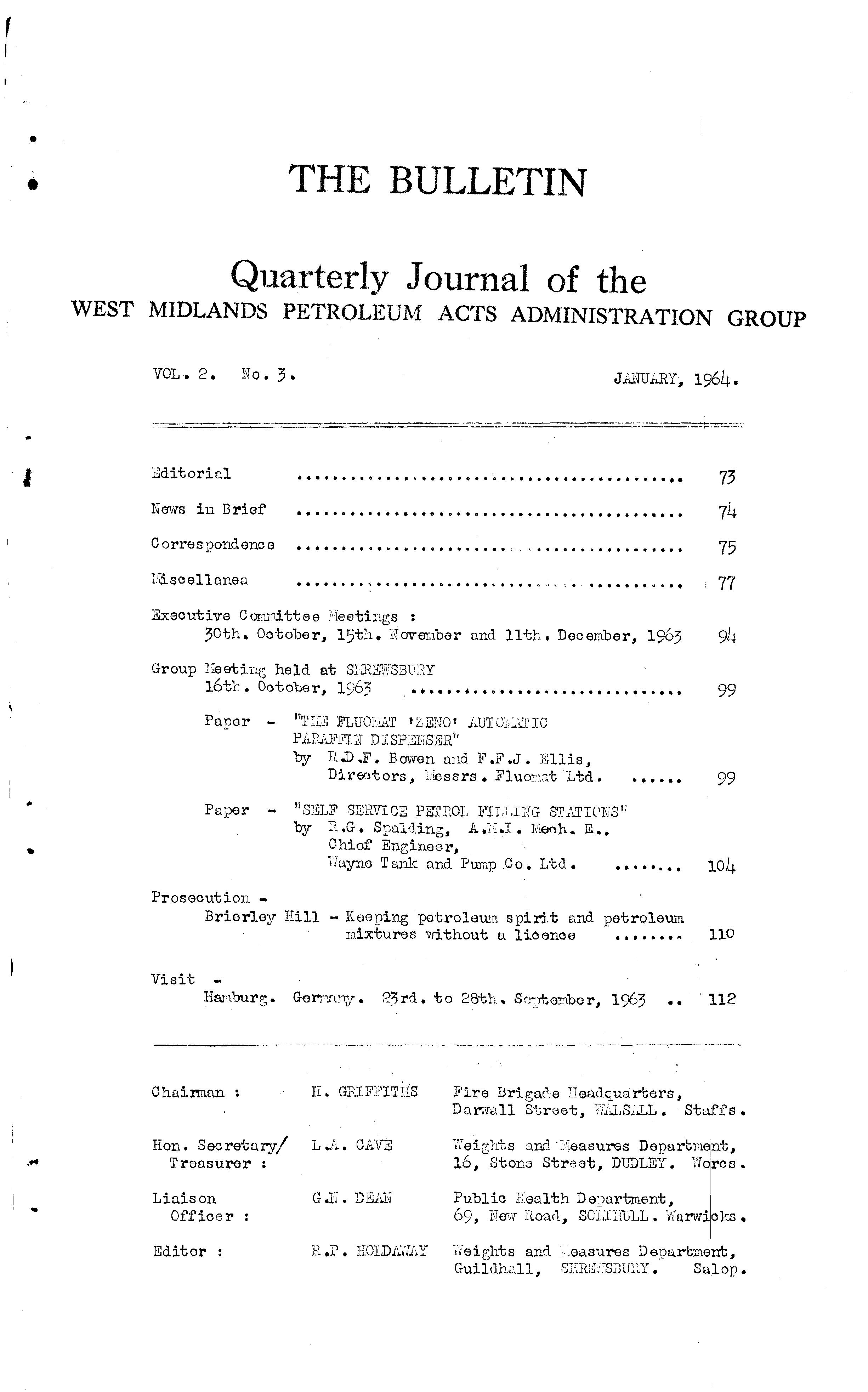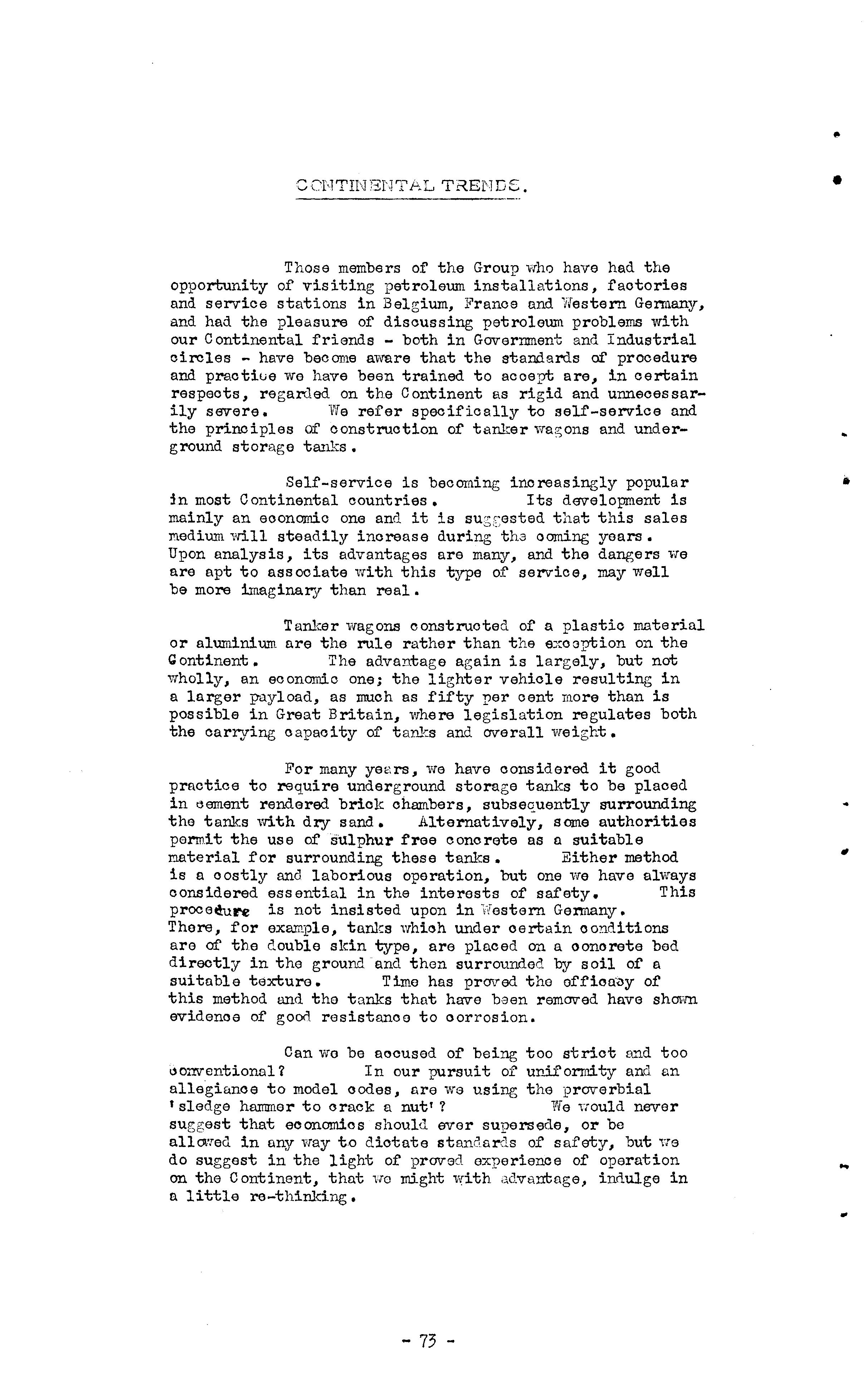NE\VS IN BRIEF
NEW Crewe N.B.O. Do:w'ley U.D.C.
st. Holens 0 .J3 .0 • War;[ickshire 0.0.
ASSOCIATES
Hr. J. Gaskell Ll.A.P.H.I., M. Inst. P.C ., Chief Public Health Inspector.
}Ir. C .G. Rhodes, }\J:.R.S .H., Chief Public Health Inspector.
lVir. Adarns on, M.1."V! • , Ohioi' Inspector of V[eights and l'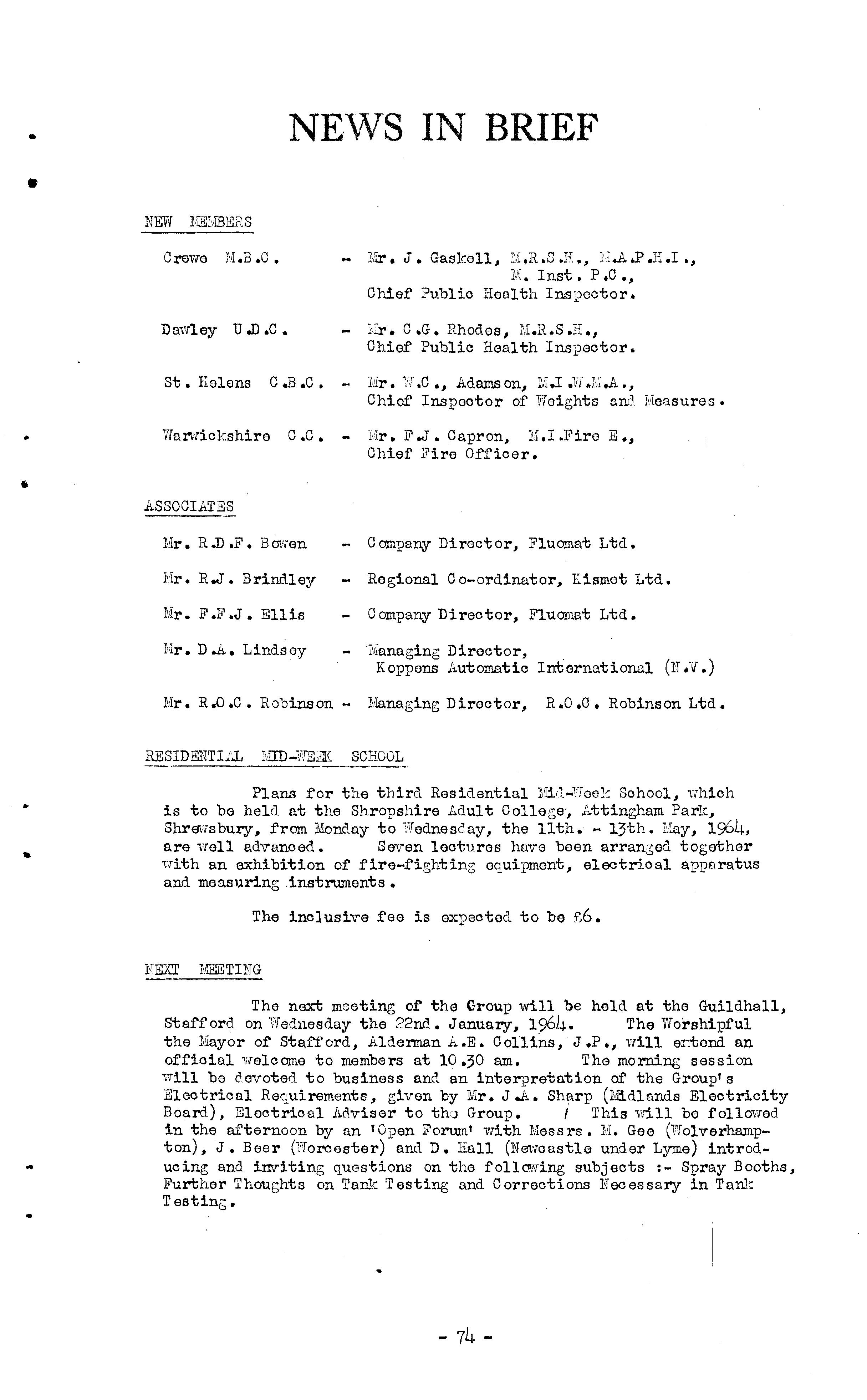
.. • •
..
74
OF FIRE EXTH·JQUI3HB::1S.
To The Editor, I1The Bulletinii

Sir,
I reaa with muoh interest the synopsis of the p8per presented by j;.'J.r. H. Grii'fiths whioh was reproduced in the October, 1)63 edition of liThe Bulletin!'.
I would li!ce to :lrurr attention to one point which I thinl:: importe.nt and that is the quite recently established fact that the pO\lvdar used in marw dIjr pow·der eJ:tinguishers is incompatible with foam. These p<JI.vders have the unfortunate properly of tending to break ("lawn foam. Thus_ if a fire is firsttuckled with foam an(1. then with an inoompatible works against the other and the fire may blaze msrrily on.
I have no doubt; that industry will in time resolve the difficulty there are compatible p<Jolrders alreadJT but in the meantime, it might be vnse to avoid admixtures of foam and dry powder extinguishers in a single looation.
As to which type should be installed, there is much to be said on either side and no doubt we eaoh have our own preference.
Yours
L.C .c • w.a .R. DALE.
To The Editor, lIT he Bull etin1 :
Sir,
Thank you for giving me a previaw of Dale's let-bel'.
I'!Ir. Dale is quite right of oourse an.cl the point he makes is a· good one. Readers may be interested to Imovv that the metallio stearate oomained in dl"lJ pO\Iv('ters brGaks down the foam as it is applied owing to an interaction the fuel and the stearate which affeots the skin of the foam bubble and oauses it to oollapse, thus the foam blanket.
I think the danger more likely where extinguishers only ara used,; I do not think there woulcl be any trouble where small quantities of dry pa;vder (from extinguishers) were up by large quantities of produced foam.
75 • .. •
As Lir. Dale rightly states, the solution is to avoid the placing of dry PO\ivder foam extinguishers at any singJje or adjoining risks and this policy is recommended in my Authority. IIy ovrn Ilref'ereno0 is for foam, aH;hough I would be the first to admit that dry powder tJ8.n be used to good effect under oertain conditions.
Yours
To The Editor I1The Bulletin"

Sir, "w rather unusual experience in the maJGter of the storage of crude oil may be of interest to the readers of your Petroleum Group Y'BulletS-n?;.
This is an oil producing a:rea ·with several (about 6000 feet aeep) in the Urban District. number of wens the oil is pumped to a tanJ:: at the cemre 0f each group of wells.
oil "\lells
From a a well in
The petroleum development company had no licences from the local authority for the storage of petroleum.
I therefore, in conversution with the area surveyor for the company, asked ·why there Was no licenoe and vlhen that thl3ir legal de::;>8.rtment held that they were eXG!llpt from suoh necessity, asked for a letter noUning the Act of Parliament and the relovant section giving the exemption.
Shortly aftervrards the area surveyor telephoned m.) saying that the legal dep",rtment nmv agreed that lioences ViTere n..3cessary and asked for the application forms •
It is not generally realised that crude oil has the light fractions dissolved in it and so comes ·within the operation of the P0tro1eum .A.cts •
I must emphasise that there are no conditions ·which I should mskJ (after consulting the Fire Officer) . which were not already conplied 'with by the Oaf,lpany. They are most co-operative anO., of course conscious of their I responsibilities to the general public.
Gainsborouz;h U..D.O •
• • • • •
V{alsall. 1I. GRIY.:?ITHS. G;::\.UGB: OIL An:: •
76
PETROLEUi/l FANEL REi?ORT TO THE CCUl\ICIL OF THE INSTITUTE OF -"lEICHT;: AND dated JUNE, 1963.
(1) Size of Vent Pipes to Underground Storage
The Panel hns oonnidered the mutter of the size of vent pipes to be fitted to underground petroleum storage tanks 'vvhioh hus been raised by Hor:mcm K. YJhitehend of B1nokpool and by Pu..'1lP 1Inintennnoe Ltd. The :mat-\::er hns been oarefully oonside.red to:.;ether with de<tn bnsec_ on experimentnl results obtnined and published by Shell Internationol Co.
Normally the rnte of gravity disohnrge from n petrol tnnker to underground stornga is npproximnte1y 80 gnllons per minute or 770 ou. ft. per hour. At this rute of florv the hend loss per 10 feet of lit vent pipe is 0.58 11 of wnter, 'Thi1e the loss for 2'; diometer is 0 _15" of In both ouses the loss is quite insignifioant und for 0.11 purposes there would be no reduotion in time if the vent pipes of the larger size ';rare used. On the other hand" the rise in head. loss when using 111 diameter pipes is quite mnrked, being nbO\'lt 4.4'1 of \vater per 10 ft. of pipe nt 80 gnl10ns flow per minute.
The Punel therefore recOlT'J:leno.s to members that vent pipes of 11l diometer arc but novertheless nre I adequato for ull oupuoities of underground petroleum storn;:;e tanks and in the interests of uniformity should be nooepted ns stnmnrd •
(2) Bent Vent und. Suction Pipes.
The Pune1 has oonsidered tho quostion ruised by I·;;r. L. Burroll regnrding this :matter und nre of the opinion thrtt bent vent und. suotion pipss should bo nllol.'Ted on tho folloHing oonditions :-

1. The metul of ,,-,!lioh. the pipes nre mnde should be suffioiontly mnllenble to bend viithout undue strain.
2. In the oUSa of galvnnised tubes, oold bonding should ba used and the gUlvanising should sho\'-T no signs of disturbanoe or ornoldng •
3. The bending of pipos should only be ponnit-ced where tho rodius of bend is not too amnll, sny not less them 6 11 9" Ylhoro oarried out by n proper bonding meohine.
2" gulvanised pipes are normally tastod to 200 lb. p.s i. ber ore loeving the faotory.
The Inspootor ()[\rriod out n pressure tost on the linos bofore approving the instnllntion
The following ]]'1Qtters i7oro tekon into oonsiderdion by the Pnnel :(0.) (b) (0 )
One mombor of tho Punel hus -m-ro instr.11ctions in his aron 1:vhoro bent pipos nre inoorporctod und whioh lIfG:re tested to
l\1ISCELI..,ANEA
77 .. •
.. ..
100 lb. p.s.i. TJi th no adverse et'feots. Enquiries have been made and cm;=ineors h::we expressed the opinion thet insistenoy on solid elborrs TTaS out of date and thot prhporly bont pipes era snfer ('.nd onsier to use.
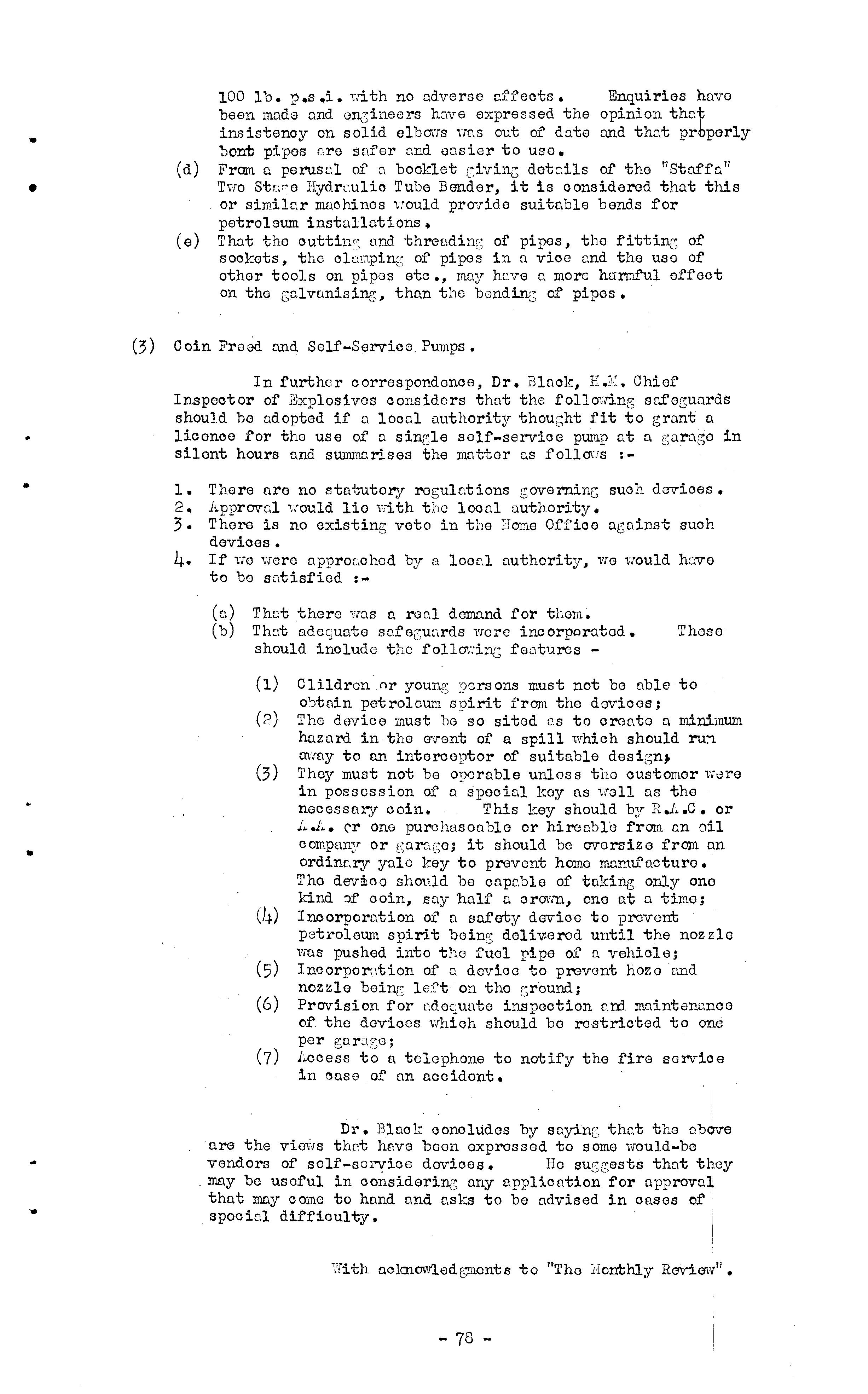
(d) From C\ perusd of Cl booklet CivinC det::-.ils of the !1StClffu ll Two Str:r'e Hydrc.ulio Tube Bender, it is considered thot this or similc\r maohines i-rould pr07ide suitable bends for pEltroleum installations.
(e) Thc.t the outtin"; und threading of pipas, tha fitting of sookets, the of pipes in a vioe cnd the uso of othor tools on pipos atc., may he.Ye 0. more hnnni'ul effoot on the galvo.nisinz" than the bondins of pipos.
Ooin Freed and Self-Servioe Pmnps.
In further correspondonoe, Dr. Blaok, Chiof Inspeotor of Zxplosivos oonsiders that the should be adopted if a looel authority thouGht fit to grunt a lioenoe for tho use of a sinGle self-servioe pump at a in silent heurs and sU1lllnnrises the mattor as follous :-
1. There are no l'Ogulc.tionsgoverninc suoh devioes •
2. ApprovGl i:ould lio Yri th the looc,l authority.
3. Thore is no axisting voto in the IIone Offico against suoh devioes.
4. If i-,ra ,',raro npprof.\ohod by a 100['.1 nuthority, '."re 1irould he;vo to ba SGtisfiod :-
(n) Thct there TI'O.S a real demnnd for tLe!n.. (b) Th[lt adecjuato safe(:uc,rds woro incorpnro.tod. should includG the i'ollar:in.::; footures
(1) (2)
Those
Clildron nr younG persons must not be able to 0':Jt8in petroloum spirit from the devices; The device must be so sited es to creato a minimum hazard in the event of a spill which should l"U:"1 mmy to un intercoptor of suitable They must not be operable unloss the ';0re in possession of a spocie,l koy o,s 17011 us the necossary coin. This key should bJr R.A.C. or C'r ono purchl1soablo or hirenb1'e from en oil or [Snl'DG;oj it should be oversizG from an ordinr.ry yula key to prevent homo manufacture. The device should be oape.ble of taking o:n1y ono kind ':'>f ooin, any half u crorrn, ono ut a time; Incorporation of n safety devio'e to prevent potroleum spirit beinG deliv.erod until the nozzle 17ms pushed into the fual ripe of n. vehiole; Incorporntion of (\ dovioo to prevent hozo and nozzle bainG left on the Provision for inspeotion r.n:l ID.':Iintenc.nce of the dovioes v[hioh should be restriC'l:;od to one por to Cl telephone to notify the fire sorvioe in ause of nn accidont.
Dr. Blaok ooncludes by suyinG thc.t the above are the ViOV1S thr.t hnve boon expressed to some would-be vendors of self-seryioe devioos. Ho sUGgests that they mny be usoful in oonsidering any application for approval that mny com.e to hand and asks to be advised in oases of spacial difficulty.
':Vith aclcnovvledg!llOnts to "Tho iIonthly Rovie1iil'!1 •
• • • • ..
78
Contributed by Wayne T aIllI.: and Pump Co. Ltd., Braclcnell. Berkshire •
Th.e petrol r.letering purlP c El parre r driven pumping unit delivering air free spirit through a meter, 0. counting devioe reo ording the noveDent of the meter and 0. number of other units including a oontrol nozzle, filters and soneth16s auxiliary devices for autmf,tio control.
The unit is coupled by a suotion pipe of adequate size to an underground storage tank cnd although purlps of 0. ,vide variety of types can be mado, tvvo types only are in vlide general use. These are the sliding vane rotary type and the internal gear typo. Both operc.te on a positive displacement principlv, givo good vfficiency und have good self priming oharacteristics. They are also adaptable for operation by hand in an emorgonoy, through a suitable auxiliary attaomJ.ent; an imporlnnt standby in the evont of porror cuts or eloctriflal breakdowns. The sliding vano type has six vanes guided in slots in an ecoontrioally :r.J.0unted rotor. The vanes are held against the f'C\sing walls by floating spaoer rings housed in counter bores ut euoh end of rotor and as the rotor turns in an anti-clockrlise direction, fluid flo1:[s in betl;'lOen its l(YNer sido am the ccsing und is trapped by the vnnes ::md fore ad out of discharge. The punp has an inbuilt suction strainer am a by-pass valve is also inoorporated to oirculate the flow "hen the ptl2".lp is turned, but free discharge through the systen is prevented, us for by olosing of the nozzle o0ntrol valve.
The genr type is based on the prinoiple that the nesh of the t1-.ro gears pruvides the contaot neoessary to nalee 0. good seal T:hilst the :)resoent pruvides the aucrbion And disoharge for the outside dianeter of the idler teeth and th-.t inside dim.l-.Jter of the rotnr tooth. In prnctioe, this type of pU::1P is o.lso provided w'ith 0. suction strainer and 0. by-pass v0.1ve.
On leaving the punp, the petrol passes into the air separator "There air and vapours are separated frOlJ. the spirit and vented to atnosphere. The air separator is divid.od into trIO interconneoted units; the first being 0. ooa1esoing and the second, a float ohanber. The ubject of the ooa1esoing ohrunbor is to direct the flaw of spirit and control its volocity to allovr bubbles of air und gas to rise to 0. point where they oan be oollocted and vented, uhilst the float oh..·"\nber the air-vapourliquid nixture froD the ooalesoing ohanber, releasos the air and vapour to ntnosphore and returns air-froe liquid to the suotion side 0f the pur2p.
Fron the separator" the spirit pussos to the neter Trhich is tho nost inportnnt singlo unit in the patrol pU:-.lp. It oan be constructed to work on a nUl-:J.ber of prind.ples and by far the nost vridely used is tho piston typo. The usual arrangonont is for the b0dy casting to bo prvvidod 'i.rith four oylinders grouped in oruciforn pattern around a contral ohcr,iber. Eaoh oylinder contains n piston" opposite pistons being oou,led in pairs by rigid yokes of the Scot"h yoke type, those yokos driving n centrnlly j ournnlled orank shaft. The noter is sinply n for:l of liquid :r.J.otor used for driving tho oountor und sono r:1.Othod. of valving is

I\I.:ETERING
79 • • • •
required for controlling t4e so that the cylinders are connected a.1ternatively to inlet and outlet a.t the end of the stroke of the pistons. Tho valve is a rotary valve containing tyil'O ports whioh oo.n put tho cylinders in oOl!lIlnlnioation -Idth oither the inooming liquid in the dome ousting or the disohnrge pipe whioh is led from tbe oentral ohambor. Tho valve is driven from the orank shaft und is timed ,nth tho stroke of the pistons yrhioh aot as primo movors for the orunk. The oounting meohanism in turn is CI.riven from the va1vo. During one rovo1ution of tho metor each oy1inclor is fillod and emptiod onco and with 0. lcnowlodgo of the S'1iil'opt vo1umo of' the pistons the oountor is o.rrangod to reoord tho total sa10.
The oounter ·\;hioh is situated above the moter is driven by u univcrsulooupling.. The moohanism of the oounter comprisos briofly. a gear train from 0. contral vertioal sha:f't to horizontal pointer shafts. Tho ratio of tho train is suoh that tho long pointer, 1Jvhioh oorresponds to tho minuto hand of 0. olook makes ono turn for oaoh gallon delivered whilst the short pointer IlllJ.kes one turn for (!Very 'b\i"Ienty go.llons delivered. The tvil'O pointers must be roset baok to tho zero position before eaoh frosh delivery ond mo.nufo.oturors usu0.1ly provide un intor1ooking devioe botvreon the oountor and tho motor gwitoh to onsure that the pump Oann(.;t bo svritohed on to offeot a dolivory boforo the oounbor ho.s boon rosot
Tho olook typo of' indioator is still widoly usod in this oountry but two developments in recording moans ure imporbant and should bo desoribed. Tho f'irst of' those is the oomputor, whioh is by fn:r tho most widely used unit in othor parts of the world. ':Chis unit not only records the volumo of spirit dolivored, but computes the totnl oost of' tho salo c:..n tho taximeter prinoiplo. }'ionns nro provided to adjust the moohanism in aooordo.noo ·with ohanges in unit prico and it is thoref'oro possiblo to soll patrol with su()h an instrU1:1ent by moneyt s worth as an alternutivo to As oxnmplos of this, 0. oar tunk onn be fillod up without stopping at nn QXaot go.llon or halfgo.llon ns irrespootivo of tho vo1urne dolivered, the total oosh aalo will bo rooordod. aoourately to tho nearest farthing. Alternatively an ovon money' a liiTorbh oon be sold instead of El sot number of gallons, suoh us ton shillings worth or one pounds worth of petrol thus (:Jutting out delays 1iil'hilst ohange is given.

A oomputer oonsists ossentially of a oontral vortiod shaft ·whioh drivos oyolomoter typo roo ording drums through D. suitable gonr trc.in. In eooh dial f'o.oo there are two banks of. rooording drums disposed ono abovo the other visiblo through reotangular holes. Tho top bank of threo drums rocords the total so.1o in shillings a.nc1. ponoo and the lovil'Or three the volumo dolivered in gallons. The unit prioe t:l:f'tho petrol is also shovm. by drums whioh· oan be adjustod in fnrthing inorements for prioe from id. to per gallon. The drive to the oash reoording drums is through 0. gear box, the ratio of' 1J'mion is 1iJhen the unit prioe is adjusted..
i
The most reoent dovelopment in oounters is lcnown Je.a tho numorator and is of'fered where prioe oomputing is not as an improvement on the old style olook type reo order. Like !the o omputor, it omploys drwns f'or reo ording the total volurno c1isJiensecl but it has the addition of a single pointer whioh tUlns onoe for eaoh gallon rlolivered. The pointer is there to assist the user in stopping aoourately at tho whole or half-gallon point and the drums viThioh reoord the total volwn.e give olarity of reading. l part from the simplified obtained ·with the numerator., there o.re a number of mechanical advo.ntag;es to bo obtained from it as its oonst-
• • • • •
80
ruction enables more accurate oounting of the meter revolutions to be mado by the elimination of baoldash in gearing and slip in t'he reset olutohes as compared iJ"ith the conventional olook type reoorder.
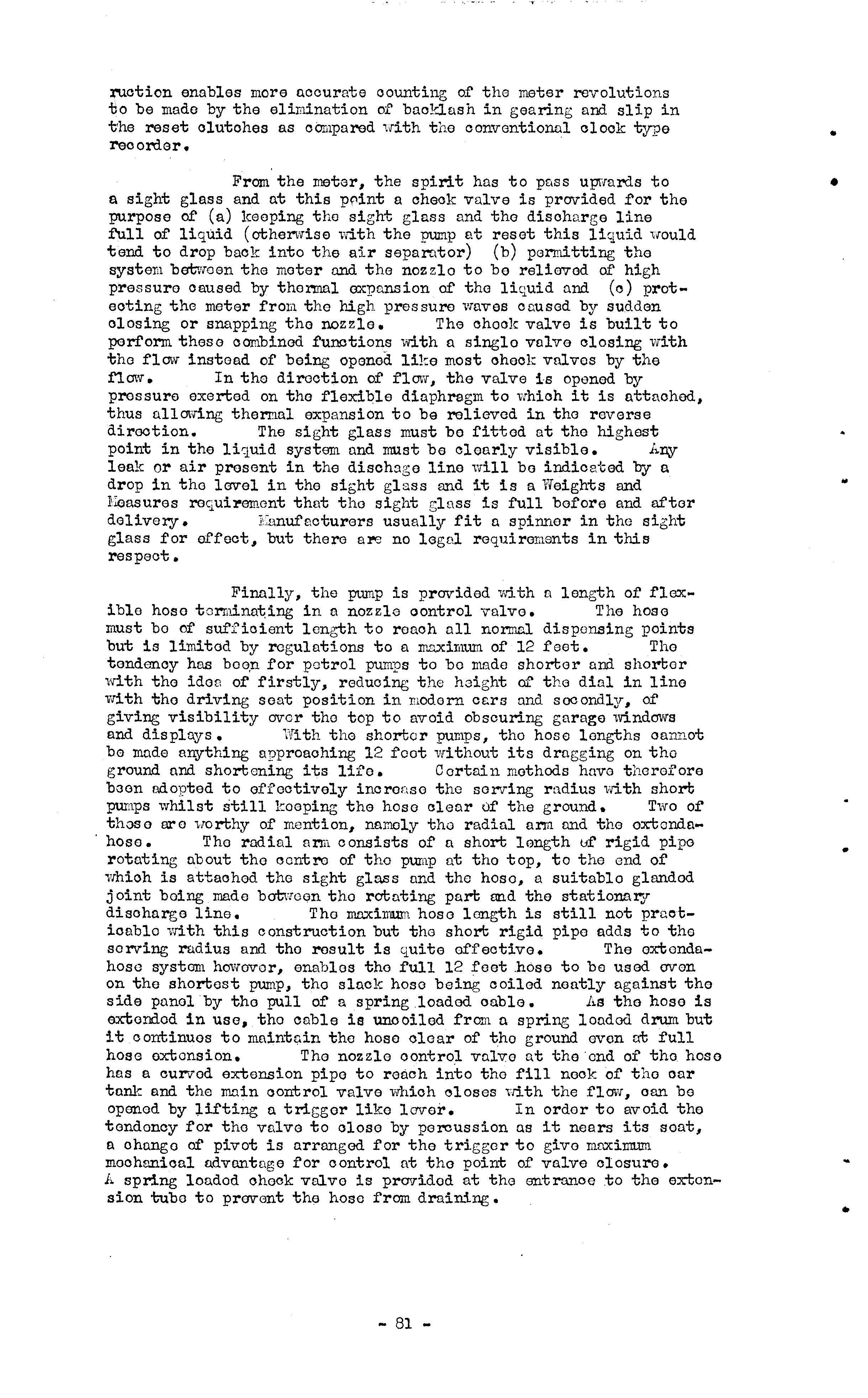
From the meter, the spirit has to pass to a sight glass and at this p0int a cheok valve is provided for the purpose of (a) !ceoping the sight glass and the disoharge line full of liquid (othe!"\Jvise .-\'l.th the pump at reset this liquid would tend to drop baok into the air separotor) (b ) permitting the system between the mater una. the nozzlo to be relieved of high pressuro oaused by thon:nnl oxpansion of the liquid and (0) prot eoting the meter from the high pressure waves onused by sudden closing or snapping tho nozzle. The chock valve is built to perform these co.m.binod funotions iNith a singlo vulve closing with the flmv instead of being opened l11'.:e most oheck valves by the flo"l". In the direction of flmY, the valve is oponed by pressure exerted on the flexible diaphragm to iirhich it is attaohed" thus ullm·,ing themal expansion to be relieved in the reverse dirootion. The sight glass must ba fitted at the highest point in the liquid system and must be clearly visible. Any leak or air present in the disohage line will bo indio£"ted. by a drop in tho lovel in the sight glass and it is a Weights and Iloasuros roc,tuil'"eIncnt thot tho sight gluss is full before and nftor delivery. l';.anufacturers usually fit a spinner in the sight glass for offeot" but thero al'e no legol requirements in this respeot.
Finnlly, the pump is provided "Vd th n length of flo:x: ible hoso in a nozzle oontrol valve. The hOse must bo ef sufficient length to reach all normal disponsing points but is lirnitod by regulations to a Il1nxim1..uu of 12 foot. The tondency has boo,n for petrol pumps to be made shorter and shorbor vnth the id08 of firstly, reduoing the h3ight ar the dial in line with the driving seat position in modorn oers and secondly, of giving visibility aver the top to avoid obscuring garage windov,s and displays. Y11th the shortor pumps, tho hose lengths oannot be made anything approaohing 12 feot without its dragging on the ground and shortening its lifo. Cortain mothods havo thorefore been adopted to effeotively inoronso the serving radius 1Nith shorl:; pumps Whilst still koeping the hoso clear uf the ground. Two o:C those arc 1rorthy of mention, narnoly the radial onn und the oxtenda... hose. The radial onn. consists of u short length uf rigid pipo rotating about the ocntro of the pump at tho top, to the end of whioh is attaohed tho sight glass ond tho hoso, a suitablo glondod joint boing made boti'J"Oen tho rotating part and the stationnr-,f disoharge line. Tho mrocil11llm hoso length is still not pruobioablc with this construotion but the shorl rigid pipe adds to tho serving r'cl.dius and tho result is quite effeotive. The oxtcndahose systam hm,ovor, enables the :Cull 12 foet .hose to be used oven on the shortest pump, the slaok hoso being coiled neatly against the side panol by tho pull of a springloadod oable. 1l.S the hOse is extended in use, tho cable is unooilod from a spring loaded drum but it continues to muintr.in the hose oloar of tho ground oven ut full hose extension. Tho nozzle oontrol valve at the end of tho hoso has a curvod extension pipo to reaoh into the fill neok of the oar tank and the mnin oontrol valvo whioh oloses i7ith the flm'l oon be opened by lifting a triGgor liko lover. In order to avoid the tendoncy for the valve to oloso by percussion as it nears its soat, a ohange of pivot is arrangod for the trigger to givo mrod:mum moohonioal advantage for oontrol at tho point of valve closure. A spring loadod ohook valvo is at the ent ranoeto the extension tubo to provont the hoso i'rom draining.
81 • • .. • •
j" numbor of automa'l:;ic oevices have been developed for petrol pumps, but tvro Trhioh are itvidely employed are the presot and the automatic zoroising devioe. The preset is an automatio oontrol devioe vrhioh can be sot before a delivery is made for any quantity i'rom 0 to 20 gallons. Yfuon the exact pros0t quantity has boon meohanism-oontrolled valve automatioally c10sos d.n the disoharge line thus tald.ng the 'rrhole oomro1 responsibility out of the operator's hands. Yrith automatio the elootric motor vrhioh drives the pur.ilping unit is also ooup1ed to the zoroising shaft oi' the counter through a belt drive and a olutch meohanism. l. .. s the motor is switohed on, the oounter is automatioally drivon baok to zero by tho motor and then tho drive is de-olutohed. This eliminates the noed for manv.a1 resetting and hence spoeds up service and it also ensures that the oounter is at zoro bof arc oommenoes so that an interlooking meohanism is r..o longer necessa:r"y.
In oono1usion, it Tdll be appreoiatod thnt the i'orogoing represonts a very brief desoription or a petrol metering pump timd furthermore, that individual IOOnufacturGrs vo..r:l the oonstruotion and layout of the units in accordanoe vdth thoir mm school of thought. It might perhaps be mentioned, hovll'(JVer, that thoro are in oxisteme oertain regulations 'whioh apply to equipment of this nature and thoso regulations influenco design to same oxtont. The Weights and. 11easures rogulntions lay dorm stundards for moasurGnGnt aocuracy and nlso the broad proviso that the esuipment shall not be oonstructed ns to faoilitate the perpetration of frc.ud, whilst tho HOl7le Offioe i'or their part, hrore frnmod model regulations regnrding oleotrical equipment ad oortain other matters in order to protoot publio sufety.
CAT BRII\lGS TROUBLE
'When El British Road Servioes lorry was travelling throue;h the village of Pulhrun St. NorfoH:, the o.river S1Iverv-ed to avoid a black ont. He lost control of the lorry, whioh skid.d.ed aoross to the neur side and collided with a parked private Tho car was pushed around and into a die sol pump on the foreoourt of' a garage, demolished the pump, und oame to rest straddling the pump base.
The lorry then left the road oompletely and trovelled the length of the foreoourt tuldng vrith it three petrol pumps am an eleotric advertisement sign. It finally halted with the rear axle over the base of the third pump. The first tvro petrol pumps fired at the time of' impact and sot fire to tho lorry.
The driver's leg was trapped and he was removed by one of the garage employees. Other employees taokled the fire with foam e:rlinguishers cnd buckets of sand and suooeed.ed in axtineuishing the blazing pumps. At this stage the fire spread from the lorry to third petrol pump and theso were extinguished by the Brigade usin.:o; forun and hose roo1 jotsl_ ! .
Chief Fire Officer VI.I\[. Yrard, M.I. Fire E., Norfolk Firo Brigade, states : '"rhere was little duru.::er to the risks or underground storo.Ese tanks and 110 pe rs ons were The oat that oaused tho trouble esoaped unharmod, und the fiml iron;y 'Vv"Us that the roplC\Ooment pumps that; had been ordered for urgent delivery ,'mre drunnged by a fire at the agonts' premises in the Midlands 111

• • • •
82
by A.S. lVIinton, F.R.l.C., II.1.Fire E.(Hon), E.I nst. F., A.1 .Har. E.
This artiale is not intended to iJe seli'-o:;:;?lanatory. If the reader is not familiar , .1 th the su1Jjeot, then no attempt rill be made to HO'rrwer, to those 1;-ho hnve to deal uith the storae;e of' petroleum spirit ancl its derivo.tives there be measure or
The uuthor foils to see Tihy the handlin:,: .. onrria:;e etc. of hiGhly inflaxn:rm1)le liquids and pases should be the subject of oonfusinc Acts of' Parlicunent and lec"l require:nents ,-rhioh are antiquated and not in keeping i-rith post-ymr oheraiool developments and knO'riledse.
The situation as resnros l::nmm or undisputed petroleum liquids and their derivatives is olear c.s rof\nros legislation, but many highly fla:rmllable liquids Ogn nO'r; be derived from al te1'nativa processes i.a. from tha :?etro-chenical industry or from prooesses 'Vrhioh are not oonneoted in any way 11ith potroleUln and its produots.
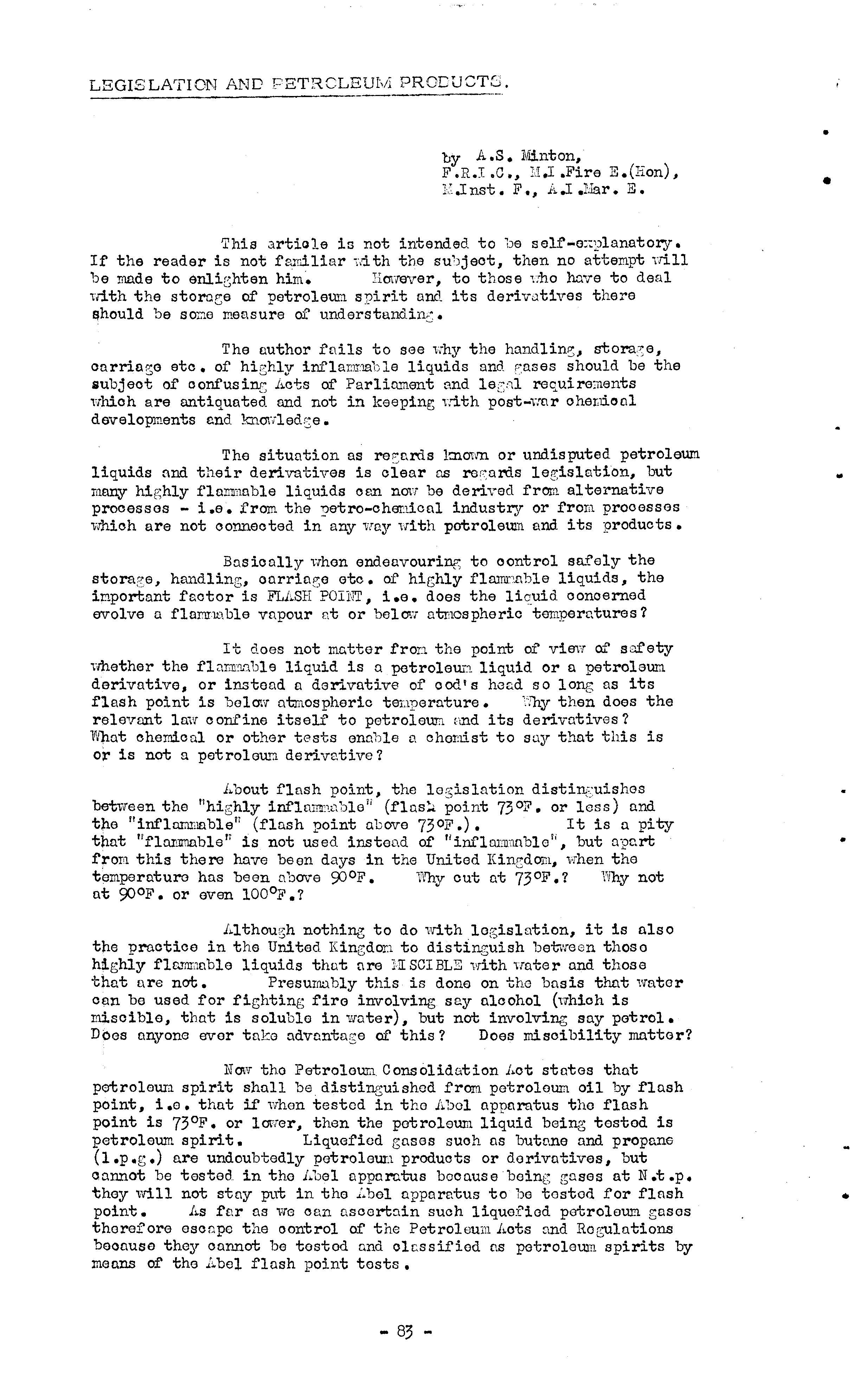
Basioally when endeavourins to oontrol safely the handling, oor1'ioe;e eta. of' hiGhly flrunr:"'1ble liquids, the inportant factor is FLASH PODIT, i.e. does the oonoerned wolve a flnnnnble vapour nt or belO":; atmospheric temperatures?
It does not matter fron the point of viewof' so.fety whether the flZlD.J:1'11Jle liquid is a petroleU!-:!. liquid or a petroleum derivative, or instoad a derivative of cod's heed so long as its flash point is bolO'rr atmospheric tenperature. :.'iby then does the relevant lm'l oonfine itself' to petroleum nnd its deriv-atives? Wl1at ohemical or other tests enahle u che!aist to suy that this is Or is not a petroleu..Tl derivc.tive?
flash point, the leco;islation distin:;uishes betlireen the I1highly point 73 0 P. or loss) and the "inflo:m,Jable il (flush point above 73 0 F.).
It is a pity that I1flnr:ID1D.blel1 is not used insteC\d of IlinflmDrmblo li , but npurt fror:l this there have been days in the United Kincdom when tho temperature has been nbave 9J oF. Why cut at 73 OF .? YIJhy not at 90 0 F. or ev-en lOOoF.?
nothing to do 1nth legislation, it is olso the praotice in the United Kingdon to distinguish betl'J"eGn thoso highly flrunr:1!1ble liquids thut nre lIT SC1BLE 'with Iroter and those that ure not. Presumnbly this is done on the basis thnt water can be used for fighting fire involving sc.y alcohol ("hich is miscible, that is solublo in water), but not involving say petrol. Does anyone wer take advantage of' this? Does miscibility :mntter?
NO'\v tho Petroleum. Consolidation states that petroleum spirit shall bedistinguishod from petroleum oil by flash point i.o. that if when tested in the apparatus the flash point is 73 OF • or 10't'Ter, then the petroleum liquid being tested is petroleum spirit. Liquefied gases suoh os butnne and propane (l.p.g.) are undoubtedly potroleun products or derivatives I but ocumot be tested in the apparotus bocause beinG gases at N.t .p. they 'will not stay put in the i.bel appare.tus to be tested for flash point. ll.S fnr os we can ascertain suoh liquefied petroleum gasos thorefore escnpe the oontrol of' the Petroleum :md Ro[s"tllations beoauso they cannot be tested and olcssii'iod ('.s patroloUl11 spirits by means of the Abel flash point tests.
LEGISLATION AND FETRCLEUI\/l PROCUCTG.
83 • • .. • •
In vim:; (YE the foct tlwt the lx:,sio objeots of the Petroleu..'1l. Consoliddion ct Lnd relevo.nt lesisl[,tion are to prescribe snfe oonditions and prC',otices for those don:;erous substanoes 1:nm7n us spirits, i.e. tboSG that will 0ito1ve flmmnnble gases at atmospheric tempercture, why distinguish between pGtrol and. methyl uloohol" or ',"orse still, "Thy exolude a substunoe 1,";hich whon not oonfined is already ['. f1mmnab1e gc-s at atmospheric temperature, namely butune or propanlJ?
Thus e:c10r,;es the purpose of this article for in prcctioo one mClY store or oonvey unlimited qUll..."1tities of peint or p1astio solvents und2r dnn&:erous oonditions provided they ere not petroleum spirits within tho rleanin;r, of the L.ot und. similarly thore apponr to be no restr:'ctions or control mror tho quantities of liqurlied petroleU1a e;nses that mo.y be stored or conveyed.
With nc];.now1od.;2:omcnts to "The Institution of Fire 3n:;inoGrs Qunrtorlyl;.
TT-LE l\;:: :JCCIl'.TION CF UUInCIPAL CCRPORATIONS ---'------
Extro.ot frOl'1 the R.eport of the Fire Sorvice Corw.:Uttee of the 1••j,:.C. duted 2nd. July, 1963. R02rinted fror.l the "Municip81 Revieiif 1 Supplement October, 1963. Paruffin VcmdiniO' lit,ohines. ._ • 1.....1 •• ••

(14) YiTntford Borou::;h Council SOUGht the vievv· of the ror;urding 1"10..-)0 to their T mm P1Ulmins Cammittoe for planninG pel"lr.ission to instnll on the private forcc ourb of n goneru1 hurO:I.'cre shop, n :m.uclline· for the uutomatio dispensing of pnro.ffin in oustom.ers t mm oontainers. It appears that puruJ.'fin is stored inside the shop and. fed into the maohino f\ motal tubo, a meusurod quantity boillf. released throuGh a spout on insertion of n coin" the intention b01ru::: that the customer shall p1aoe his O'wn contniner u:i.1.clcr the spuut, nl thour:h if this is not done for sorne roason, thero is nn overf1ovv tray provided.
(15) Wntford viewed the proposal 1:lith SOl'1e ooncern especially in view of the fire risk involvod, it boin3 olonrly only too easy for same oureluss person to spill paraffin ovor tho forecourt and cvon more oasy for nll ill-disposed person to throw tho "hole qu:mtity disponsed over the forecourt and sot lisht to it.
(16) similn.r let'Gor was received frurn Bootle County Borou:,.;h Cuunoil yrhioh drar: u:b'contion to the felet that the of Housins ond Locnl Govcrmn,Jnt hf\d stnted thet the possible misuse of pnrnffin !ll.:..\ohines by youths om other persons , wes not a sufficient reason for plrah'1ine; permission.', The Council fJol that Tv-hile theso m.c.chines m.uy in faot be so ! crected fi1.d IrJ.lintc.iu8d as to Cf.1.USO no fenr of firo risk of
t of tho ·:m.nohinos lor.dinr, to oonsidorable fi 0 n gr?YO hazard.
I
(17) Wo wore informod th::.\t this matter hed. boen Qonsidorod bY n sub-oommittoe of tho Law C0!!11Uttoo iifho mnclo the SUi';p;ostion" 'with -rrhich TVO tI(?rOo, that, .in .viO'w of the dancer to public safety whioh mif,ht arise fror.'l tho installation of such i t be useful to discuss with tho Homo Offioetho practioal aspeots of this kind of risk whethor it is possible to ensuro further protection of the public.
• • • • •
-.--.-
- 84 -
ASh'TmJ mm]]]?.. LYHE.
llir. P.J. Poulter.
92 premises yrere licensed for the storage of petroleum spirit and petroleum miJ:tures. 1 carbide of oaloium store vras licensed.
the period under review I 198 visits ,yere to premises to ensure that tIle conditions of licence 'v'ere being observed. The ullage testing of 10 underground stora;e tanks and pressure testing of their associated suction lines was carried out with satisfactory results.
In accordance 'Vnth the provisions of Section 73, Public Heal th hct, 1961, 5 derelict underground petrol tanks vrere inspeoJced to ensure that they were beinp; maintained in a sufe condition.
BRo-;rrOOLLS U oD.C • Mr. R.H.
There are 42 premises licensed for the storage of petroleum and/or petroleum. mixtures within the district. l:p visits of inspection to stores were made. Close with the Engineor and Surveyorl s Department cnd the Fire Prevention Officer of Staffordshiro County Council Fire Brigade has been maintained in order to ensure that all reasonable precautions are taken in the storago and use of ";Ihat is potentially a VO'rlJ danf,erous substance.
DE.RBY C.B. Hr. ",if IH. I-:uttheTfS I
At the olose of the year 1962/1963, there were 279 licensed p'romisos -,nth authorised stornge of pctroloUlTl spirit, petroleum mixturds and carbide of calciu1'l. i. tot::.l of 286 liconces had boon gr..mted, of which 13 were for no','! or additional installations. The revenue receivod amounted to £237.8.6.

total of 799 visits to licensees! premises wero made, of which 625 visits wore day-tO-day attendanues :I:'or the super-..rision of nm'r constructions ono inst ullut ions , and 174 visits were to existing storage plo.ces to observe that the roc;uiremonts of the Act and the local authorityts conditions uf lioence oontinued to be c'omplied with.
32 tanks which had bElon installed for morc than 20 yoars were subjocted to prossure test; 11 were condomned as \lni'it for further storage use.
D1..1DLEY C .B • Mr. L .11.. C'ave.
150 lioences were issued ooveriD6 the storage of 366,512 gallons of petroleum spirit and mixtures. 1 oarbide of 0 aloiurn store ':vas lioensed. Lioence fees amounted to £122.7.6.
360 visits i.vore made to premises to ensure thut full c ompliance 'with the 1 ioenoe oonditivns '''IUS being obs orved •
Cave observes thQt it is c. for ,regret that the Annual Report of H.E. Inspeotors of Explosives lists no less than 60 accidents imrolving potroleun1. spirit and petroleur:c mixtures. Acoidents that in many cases oould easily have boen avoided had a little oare and thought been exorcisod.
EXTRACTS FR(Xh AIJNUAL RE::-JORT3
'.--,
85 • • • • •
RUGBY U.D .0 •
Hr. E.V.
91 petroleum spirit lioenoes and 10 petroleu."'Il lJ1..ixtures lioenoes v,ere issued to 92 premises ....,i. thin the distriot. There were 9 now installations during the yea r.
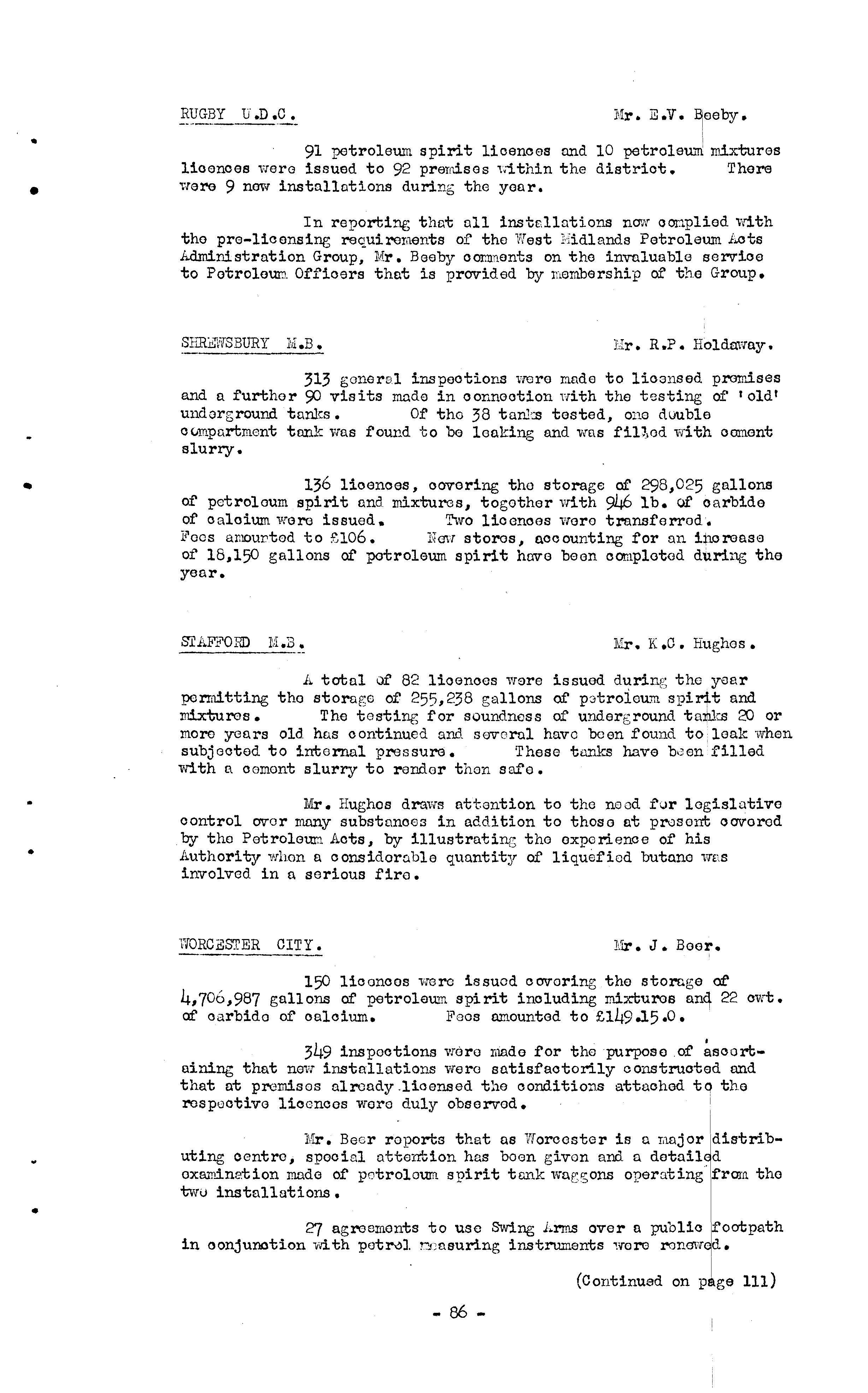
In reporting that all inst""llations nmv oOl'J.plied ·t;d.th the pre-licensine requirer!lents of the 'trest Hid1ands Petroleum Aots b.dnd.nistration Group, Mr. Beeby oor.unonts on the invaluablo servioe to PetrolourJ. Offioers that is provided by r'lombership of the Group.
Hr. R.P. HoldwJ't\y.
313 goners.l inspootior..B vrore made to lioonsed pro!l'.ises and a furthor SX) visits mode in oonnootion Trith the testing of t old l undorground tanlcs. Of tho 38 to.nl::s tested, one d.ouble ovmpurtment tonk was found to 00 looking and wus fined vdth oement slurry.
136 lioenoes, oovoring the storage or 298,025 gallons of petroleum spirit and mixtures, together with 946 lb. of oarbide of oaloium wore issued. 'nvo lioenoes were transferred. li'ooS amou!'tod to £106. How stores I acc ounting for nn rense of 18.150 gallons of petroleum spirit hove boon oomp1eted during the year.
illAFFORD M.B.
Mr. K.C. Hughos.
total of 82 lioenoos wore issued durin@; the year pcrrnitting the storago of 255,238 gallons of p8troiou:111 spirit and mixtures. The tosting for soundness of underground taJilks 20 or more years old hns oontinued anit sevoral have been found to leak when subjeoted to internal pressure. These tunks have b,HJn filled with a oemont slurry to rendor thon sare.
Mr. Hughos draws attention to the need fur legislative oontrol ovar mony substo.n00s in addition to thoso at PNsont oovorod by the Potroleurl Acts I by illustrating the experience of his whon a oonsideruble quantity of liquefied butano 'liIT.S involved in a serious firo.
WORCJ:!:STER CITY.
J\'ir. J • Boor.
150 liconoos i'mre issued oovering the stornge of 4,706,987 gallons of petroleum spirit inoluding mixturos anq 22 owt. of oarbide of oaloium. Fees nmountod to £.149.15.0.
349 inspactions woro made for thopurposoof uining that nov... installations wero so.tisfaotorily construoted and that at promisos already.lioensed the oonditions attached tq the respootive lioenoes wore duly observod. I
1\:1r. Beer that as Worcoster is a r,lajor Idistributing oentre, spooial attention has boon givon and a detail d eXaJll.ine.tion mndo of petroleum spirit tonk wae:Sons operating' from the tvvu installations.
'Z7 agreements to use Swing i ... rm.s over a publio footpath in oonjunotion vd th potNJ. r:');asuring instruments 1\1"01"0 renmv· d.
• • • •
I (Continued on page 111) 86
by J. 11:1c D. Ea11iday Deputy Chief Inspector Ce.ro.brldge City V"ieights & J"Ieasures Department.
This method of underground tank testing has been evo1v·ed after long oonsideration and ultimate rejection of other methods as being inoono1usive and in some oases inaccurate and although the initio1 expense for equipment may be relatively high .. taking into aocpunt its long life and its use as a matter of public safety, it is not considered exorbitant.
The system oonsists basioa1ly of the average temperature of the oontents of a tank and an ullage reading oompared with sirll.1ar reDdings taken after n period 9f tlrenty-four hours.
The used is en electric Distant Re2ding Thermometer, supplied by the Cambridge Instru:m.ent CompD.ll¥, os-pable of reading to 1/20 th. of degree Fahrenheit I'll th a range of from 30 to 70 0 F. The temperature sensitive element is coupled. by means of a feet flexible lead and has a speed of response of one minute.
The Ullage gauge, designed and mnde in the Department oonsists of a o;ylindrical oup f'itted with a bleed holo and containing tv-ro i th. inoh rods terminating in points .. one slightly higher than the other and thehighor point being just belmv the, rim of the oup. The oup is attaohed by means of look-nuts on a ooarse throaded rod thus roughly looating its position. This rod by meons of a suitably ohosen thread, is fitted at the top to n mioromoter head so ongraved that tho value of one division on the miorohead equals a vertioal movement of the points in the oup Or two thousandths of one inoh. The miorometer head being fixed into a brass bush which is screwod on to the f'ill-pipe of, 0. taIlle and remains so fixed for the durution of' the test. Duo to the petrol only being oblo to enter the cup through the bleed holeJl surge is eliminatod and it is easily possible to deteot differenoes in level to an aoournoy of one thousandth of an inoh.
In practice the tnnk is fillod to within ten g£'.llons of its maximum ocp8.oity; more cuu.ld possibly trap nn air pocket should a tnnk be out of lovel und Imy air so trapped 'VlOuId bo liuble to undesirable therool nnd barometrio vf\riv.tions.
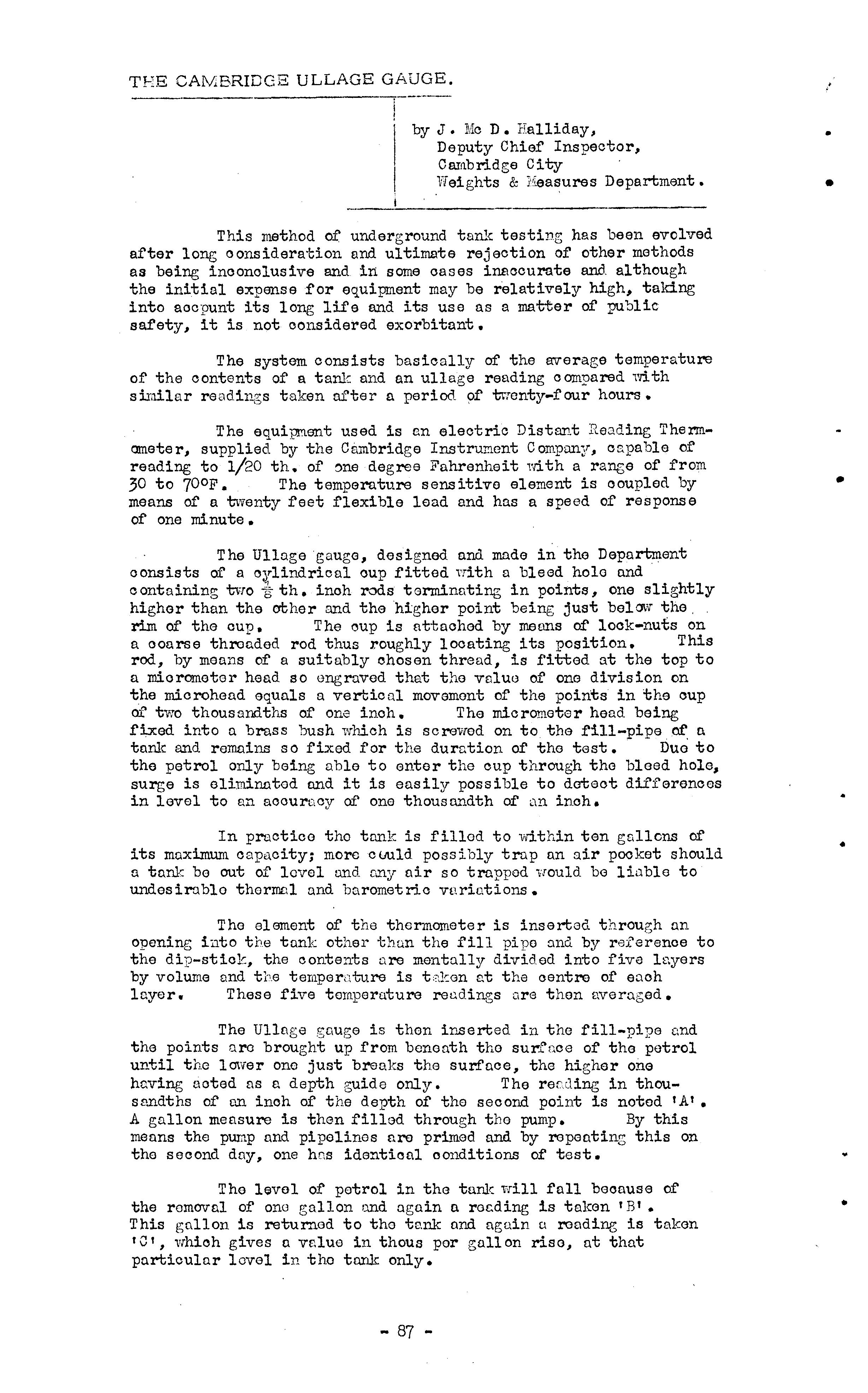
The element of the thermometer is inserted. through an opening hlto the tank other thun the fill pipe :md by referenoe to the dip-stiok, the oontents ore mentally divided into five 1uyors by volume and temper,:\ture is t,:;lcon Cot the oentre of ouoh Inyer. These five temperature reudine;s are then averuged.
The Ullage gouge is in the fill-pipe cnd the points arc brought up from bene nth the surl'noe of the petrol until the lmver one just breaks the surfaoe, the higher one hcving noted ns n depth guide only. The reclting in thousandths of en inoh of the depth of the second point is noted 'A' • A gallon mensure is then filled through the pump. By this menns the and pipelines are primed nnd by repenting this on the second day, one hGB identioal oonditions of test.
Tho level of petrol in the tuIlle will fall because of the romovnl of ono gallon und again u recding is taken 'B' • This gn110n is returned to the tc.nk and again u roadirl.f; is taken 'C', which gives a vr.1ue in thous per gall on rise, at that particulnr lovel in tho tank only.
TEE CAMBRIDGE ULLAGE GAUGE.
87 • • • • •
Tho aotua1 volumetrio test is made cftor the gallon measure has beon filled and these tvro sets of readings, both temperature and volumotrio I are taken on sueessive days and tho difference in average tonrperaturo is oonverted to volume in pints by tnldng the ooeffioiont of oxpanS ion of petrol as being 5 pints per 1000 bu1lons per degree rise Fahrenheit, (this is a workable I)ooff'ioient, a more aoeurnto one is 5 -035 pints) •
This riso or full oon be oompered ,vi th the volumetric rise or fall b;)r moans of the value o;jteinoG in thous per gallon ,Ihen one gullon liVOS returned. A differenoe 0£ up to «no pint is oonsider-od aocoptcb1o nt any tm1.k due to observntione1 Qnd instrumont orrors etc. Here follovrs some examples taken at random from our roe ords :-
Test no. 1.
Tank capaoity 500 gallons.
Thus average
T ompernturo
5 )
1st. day 6J .2 59-45 59'5 58·9 57·8 59·17
2nd. day 59-8 59-2 58·6 57'9 56 .95 --5 58.49
T omporaturo oontraotion -. ° ·68°F. 1'7 pints. Gaugo Roadings
First day A SO li ) ono gr-llon returned B ·703!! ono gGllon out Value for one gallon
Sec ond du;)r A '773 11 B .676 fi T he rot arc d rap =r;;= B B .027 inohes
From the value of 94' thous per gr-11on 27 x 8 94 ' 2·3 pints drop
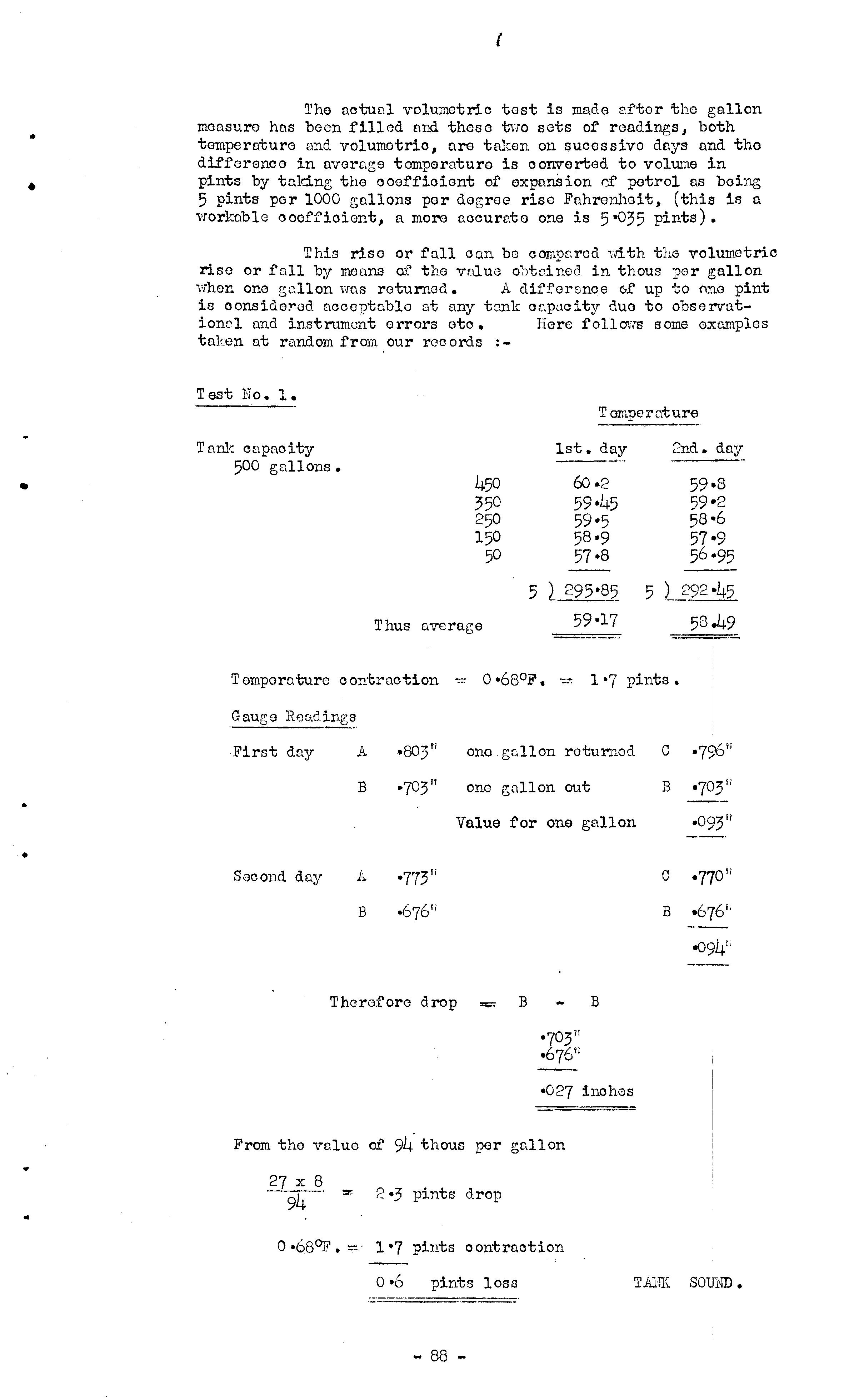
o ·68Op. ::. 1'7 pints oontraotion
C -796 1 ; B .7°3 11 '°93" C ·77°" B .676 i , .094:. pints loss
TAllK SOUlm.
• • •
• • f
88
Test No. 2.
To.ruc oapaoity 995 gallons.
Gauge Readings.
First day A B Seoond day A B Therefore drop
Temperature 1st. day 2nd. dc.y
Temporatures oomputed as before (averngocl) = 2 -1 pints oontraction 1.064li One ga.llon returned C 1.054" "94917 One gallon out B -949" -115 11 .1 0 5 11 -962 1i c -938'1 -834" B -834" .128 11 .10411 -949 .834 0115 inohes 8 -76 pints drop .42 of • drop = 2 -10 pints oontruotion 6·66 pints loss TA11C COIIDEll{ED.
Test No 3. Temperature Tank oapaoity 250 gallons 23.9.60 24.9.f:IJ 26.9.60 225 gu1lons 59-35 59·55 59-65 175 11 59·3 59-55 59-65 1 25 11 59-3 59-55 59-65 75 11 59-3 59-55 59-65 25 !l 59·2 59-55 59-65 Averages 59-29 59·55 59·65 ---' .23-24.9 _60 Temperature ris G o -26°F. - 0.325 pints expansion 24-26.9.ti:J fI 11 o -lOOp. =- 0·125 pints exp£',ns ion

89 • •
• • ..
..
Gauge Readings.
23·9.60 A .225 One gallon returned C -203 B -055 One gallon out B .055 .170 0148 --'-
24.9.60 L. -201 One gallon returned C "173 B -026 One gnllon out B .026 -175 0147
Therefore drop e055 .026 29 x 8 .029 --1481 = I-57 pints
·26°F. rise;:: .325 pints expansion 1 ·895 pints LOSS Suction line -497 l5 l l1a8 ·81 pints drop e015 drop in "triTO days. -looF. rise .125 pints expnnsion -935 pints LOSS
TA11( SOUND, SUCTION LINg (See next paragraph)_
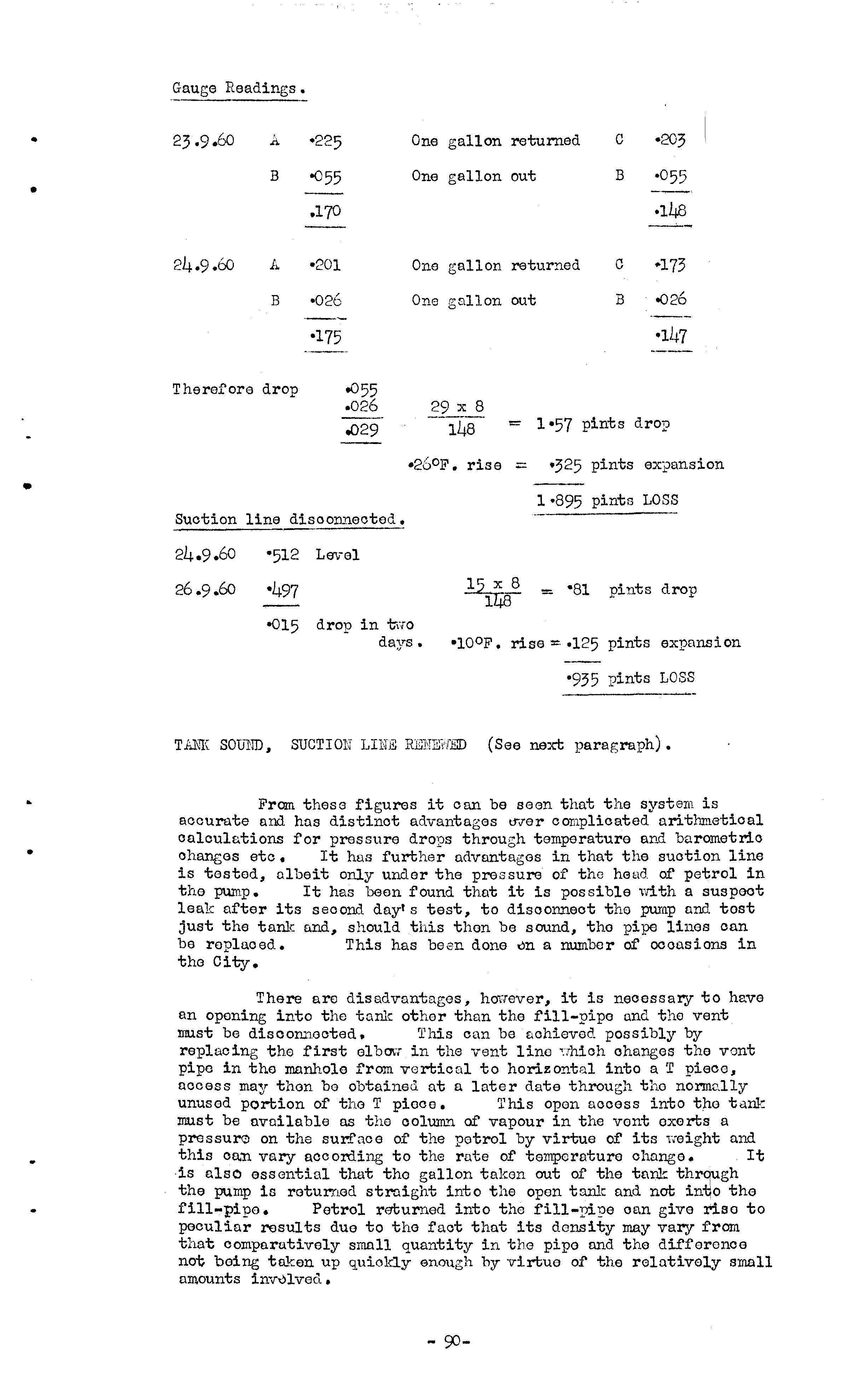
From these figures it can be seen that the system is accurate and has distinot advantages u-V'er complioated arithmetioal oalculations for pressure drops through temperature and barometrio ohanges etc. It hus further advantages in that the suction line is tested, albeit only under the pressure of the of petrol in the pwnp. It has boen found that it is possible Tvith a suspect leak after its second dayts test, to disconnect tho pwnp and tost just the tank and should this thon be sound, tho pipe linos can be replaced. This has been done .-In a number of oocasions in the City.
There are disadvantages, harrever it is necessary to have an opening into the tank other than the fill-pipe und the vent nru.st be disconnected. This cnn be r.chievoc. possibly by replacing the first elbm-: in the vent line '.7hich ohanges the vont pipe in the manhole from vertical to horizontal into a T pieoe, access may thon be obtained at a later date through tho normc.lly unused portion of the T piooe. This open aooess into t!lO tank must be available as tho of vapour in the vent oxerts a pressure on the surfaoe of the petrol by virtue of its T.reight and this oa.n vary acoording to the rate of temperaturo ohange. It is also essential that tho gallon ta.ken out of tho tnnk the pump is roturned straight into the opon tank and not the fill-pipe. Petrol returned into the fill-}?i:ge oan give riao to peculiar results duo to the faot that its donsity may vary from that oomparutively small quantity in the pipe and the differenoe not being up quioldy enough by virtue of the rolatively small amounts
• •
• •
9)-
The effect of tbe "rind passing across the top of a vent can also creute pressures, or partial vacuums and tho level of potrol in the fill-pipe, noting Qsone Qr.m of a U-tubc oan u1tor.
Perhaps I give some temperature readings from the top and bottom of a tunk, the gradost ever recorded ims 72 .0 of • at the top and 63 ·95°F. ut the bottom. This mny give some food for thought to those ,vilo were of the opinion the.t just ono reading in the oentre of a tunk: is sufficient to give tho avorage. On this tank, tho ovorage temporature YTCS found to be 67 ·53°P. and the at the oentre of the tnnl,:'Vl"Us found to be 67 _l oF., a differonce of o "43°F., or on n 1000 gallon tank, a differenoo in value of 2-1 pints. On looking through the records, some ton oocasions 1ilerc found in the last tHO years on vrhioh one temperature reading at the oentra of the taw,: did not give tho overage temporature of the ';holo tank.
I hopo thut this desoription of the method of tank tosting in Cambridgo will have provod of some interest and havo thut aocurnto tank,testing is possible and foolproof.
8'='BCIAL f'iEETING OF PETROLELJhll OFFISERS HELD AT DERBY ON THE 21st. NOVEIVSER 1963.
The Worshipful the j\:ayor of Derb;)r, Counoillor E. Maok, J _P., extended a oordial Treloo:m.G to tbirby-une Petroleum Offioers and members of Logal Authorities in the East Fiidlands, vrith representatives of the 'Vest l-lidlands ?otroleum Acts Adr,unistration Group.
In the oourse of her remarks, the :"Iayor expres sed, her appreciation of the vrurk involved in the duties of Petruleum Offioers in the proteotion of life and property against explosion and fire. 8ho hoped the de,liberatioI1S would be to the advantage of all present. Taking her leave, the Hayor exprossed her intention of joining the oompany at tea timo. lire H. Griffiths (Wa1sall) thanked the l\iT.nyor fot' her ,'re1oome.

I:r. yr .H. }Jatthows (Derby) then briefly related his part in the oa.lling of the Heoting and spoke of his pleasu,rable experionoos sinoo his L\Jcal 'authority beoame a ]!J.ember of the West I\JIidlands Petroleum AC1;s Administration Group. He th(m asked lire Grifi'iths (1Valsall), Chnirms.n oftho 'Jest rIid1anes' Group, to 0CCU!>'J the Cpa,ir.
The Ohai nn.an expressed his arm pleasure that of the other EidlElllds Representatives for the ilTvitaJeion to Derby and proc''3odoclto outline the reasons for the fonnation' of the West Group. He oxplA1nod its aimE a.nd obj eots emphasised the neoessity and desirability fUr such a Group. Continuinf;, lIre Griffiths told the l1eeting 'of tho aohievements whioh tho Group has made. 'These inoluded. recomlnendations to Looa1 Authorities tjf
91 • • • • • •
three sets of Pre-Licensing Requirer.,ents for (a) belot;r groun(l storage of petroleum spirit and mixtures, (b) above ground stora;;e of petroleunt spirit and mixtures and (c) oarbide of oalciun; , (d) a form of Report to be furnished on oompletion of an eleotrical oonditions to cover coin-operated self-servioe measuring instrun.ents for delivery of petrolew:n spirit and oil; , (e) the drafting of' mininu:m requirements for ne':; electrical installations in hazard areas on forecourts; (f) the organisation of trro successful llid-Y{colc Schools for Petroloun Officers, one in 1962 md tho other in 1963, and tho arrangements for a third School in 1964. and the publication of a Bulletin containing matters of interest to all Petroleum Officers.
Conoerning Eembcrship, t':!e Chairman said. that in the 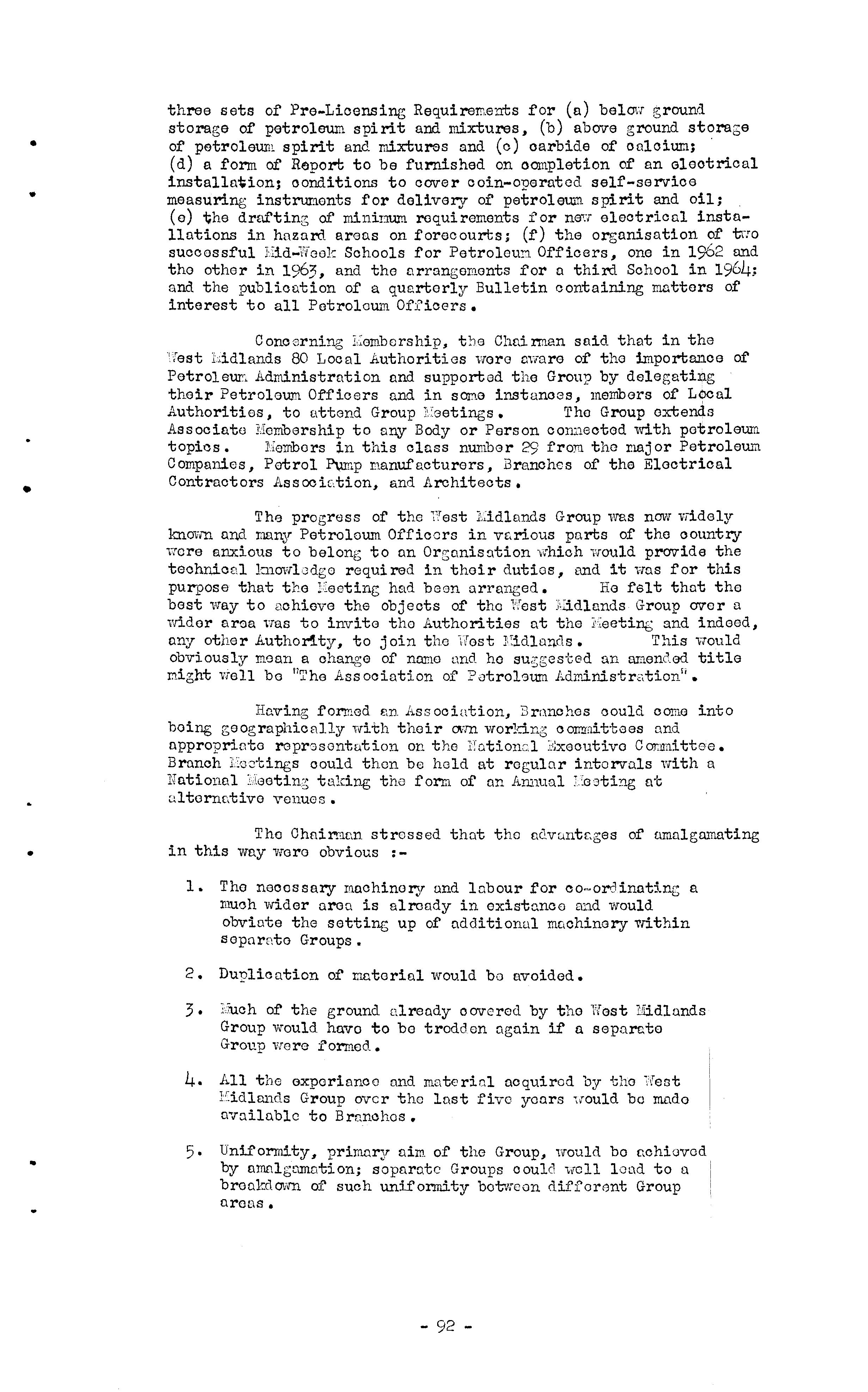
3. of the ground dready ooverod by tho West rKidlands Group would hnvo to be tl:'odd en again if a separate Group vrere formod.
4. All the oxperionce and material o.oquirod by thc i{est Eidlnnc1s Group over the lust fivo yoo.rs ,{ould bo mado available to Brnnchos •
5. 'Uniformity, primnrJr aim of the Group, w·ould bo nchiovod by nmn1gnmotion; soparate Groups could ,,{oll loud to u breakc10vyn of' such uniformity bo"bl{eon difforont Group arens.
• • • • ..
92
Tho then discuss ed tha pros and oons of amalgumntion. Some spe8kers wore of the opinion that distanco would preclude their attendance at 7iootings. ==r. Griffiths pointed out that tho Trest l.lidlnnds Group held four meetings per yoar. If the amalgamation ornris8.god materialised, tVII'O meetings could be hold in the East and t-,ro in the West llidlands. By varying the vonues, members ,,'rho 1';-ero unablo to o.ttono, ono meotinr6 could attend another.

A askod if County Fire Brigades oould join. Tho answer was l1yoS. A number of such Brigades 'yero members of the Wost ladlands Group'r.
Councillor jlirs. Brown (WirkS'rrorth U.D.C.) said it was udvuntr.scous to Local Authorities to join with tho Wost I,11dlc.nds and thought Officors should hnve full support of Local Authoritios.
Fr. Yorris (Chestorfield) suid the bost 'wny was for the East l'!Iio,lanrls to ron.nlgrunnto yri thin the Y{ost lYidlo.uds and suggested altcr.nnte mnotings.
1-11". Carbwright (Yottinghc.TI) r8isoo. the question of Officers 1 othor thnn thoso dclot;ntcc1 by Locsl J not having voting p01iro rs • lie w'ns of the opinion that mnny Petroleum Officers vrould join if they were given full Bomber... ship find ponluttocl to voto. The Ghninnnn promisocl thut this point 'would be raisod ut the next Exeoutive ;,o8ting of tho 1'[ ost l:J.dlanc1s Group.
The gencr81 foolints of the i'ioetin,j yms thut a:mnlgamotion veas to the advantago of 0.11 c.nd ::;r. o. l';illard (Skcgness) proposed that interested East L:ic11nnd Authoritios b.] imrited to join the West llidl:mds retroloum Acts Administration the cmlo.rged Group to be renamed If The Associo.tion of Petroloum Administrntionl1 • This was seoondod by Carruthors (Bolper RJ).O.). Tho proposition wos agreed unanimously.
The Chuinnun observed thc,t the T{ost ;Iidlands Group would be irnritccl at thoir noxt in Jo.nuary 1964, to agreo to the ohr.,nge of name.
The Honorary Sec rotary of the Trest 2Iidln'YJ.c1s Group v/as instructed to inforo the Cler1r..s of the Loo0.1 ; ..uthoritios of the decision of the and to extcnd :.m irrlTit"tioa to join the newly formed Associe,tion.
Tho business oftho 11eotins being conoluo,oc., delogatos then pc.rtook of light rei'roshrn.cnts kindly provided by The r!orshipi'ul the Counoillor :,rs. Z. }:ack, J.P.
93 • • • •
OF Trill OF TEE SJ;I;C"(Yl'IV!:!; OJ? T;:IE GROFP
Held at 'FolverbaIllpton 30th. October, 1963. .----------.
Present
Apologies
H. Griffiths Esq. (ChairTctan) nnd J. Beer, I{.L. Bloor, Gee, D. Hall, R.P. Holdmruy, R. Roden, J. Sharp cnd the :tlonorary Secreh,ry.
Lpologies Trere received fr01Y'. 3.V. Beeby and G.l;. Dean •
SPRAY BOOTE8. IfJ:r. Hall read correspondence he had received :t:rom the Home Office, and prolunged discussion ensued 't-rith oonsiderable difference of opinion on the licensing or other"lTise of Spray i Booths or V[orkrooms. The outcor,le of the discussion being hat the Exocutive Committee feels unable to reoo:':JD.0ncl to the Gro p the general licensing of Spray Booths. It is reo ')6nised heN l!w.y be oases 1vhero some action is desirable (md in such circ stances it is, nf oourse, open to the Local L.uthority to take action as it thinks necessary.

_REPORT OF J,D HOC LI cmrsu:G
!'lr. Gee reported gdod progress and hoped to present a draft set of conditions at the noxt moetir..g.
WIRING IN PErROL PUT':!? :;:-roUSING. :ir. Sharp reJ-cl a letter Yihich had The Secretary said. no boen sent to the E01l1G-Off1c·c. reply hus, 8S yot, boon rocoived.
PROPOSED FORT.LTIOF OF
A latter 'til'OS roud frol!l :,IT. 10ten of the Corp0ration of L'0nclon, sotting forth vim;s of the SteorinG Com:uitteo and expressing the hope that your Exocutive woulcl consider the pliints put fOr'Jnrd. j,.ftor a full analysis of the suggostions contained in the lotter, IJ[onbors of tho EXGct),tivG CJrilrdttoo decided they could not support the formution of o.n i:.ssocic,tion then thut of Looal i.uthority 11emborship.
PROPOSED EAST jJDL!jIDS GROU? The HonorDry Secroti:ll"'f :reportod hG hP.cl roceived 27 flwom:able replios froril Loool .i..uthvrities in ithe East Lidlnno.s. He also rood a in irmoh cm was extendod by thc of Derby to IIor:IDers of the J!;xooutivle Cor.1i-:iittee, to attend a first EectiT'..g at Derby in HO"J'oY:lbcr.
TEIP..D l.:ID-:.T.2iElI 8CE001. Various c.spocts '.'rere discusscel and it W'us resolvod. thc.t an ad hoo Sub-Co!iuuttoe consistil1..g of tho ChaiItr:1D.n, "nth Eossrs. Bloor, Dean, Holdo.vmy and the Eon..)rory be to c.rrunge elotails. i
.FORSCOURTS. Once morc this subject was vivisoctoo. and tho di'smomborod perts pussod ovor to lir. Sharp to romoulc1.
1.PPLICi.,TIOH FOR
The Eonorary Socrotury fivo applicc.tions for monbership. The COl"x:littec be a.ccepted.
reported I a.greed tl10y
• • • • •
94
r!IT1TUTES
OF T Ii""E ;iEETIFG OF TliE GitO-CTP
Held at Dudley 15th. Novembor, 1963.
Present Apologies
H. Griffiths Esq. (Chairnan) anc1 R. Bloor, ?:. Gee, D. Hall, R.P. Holda-;ray, J. Sharp and the Honorary S60retary.
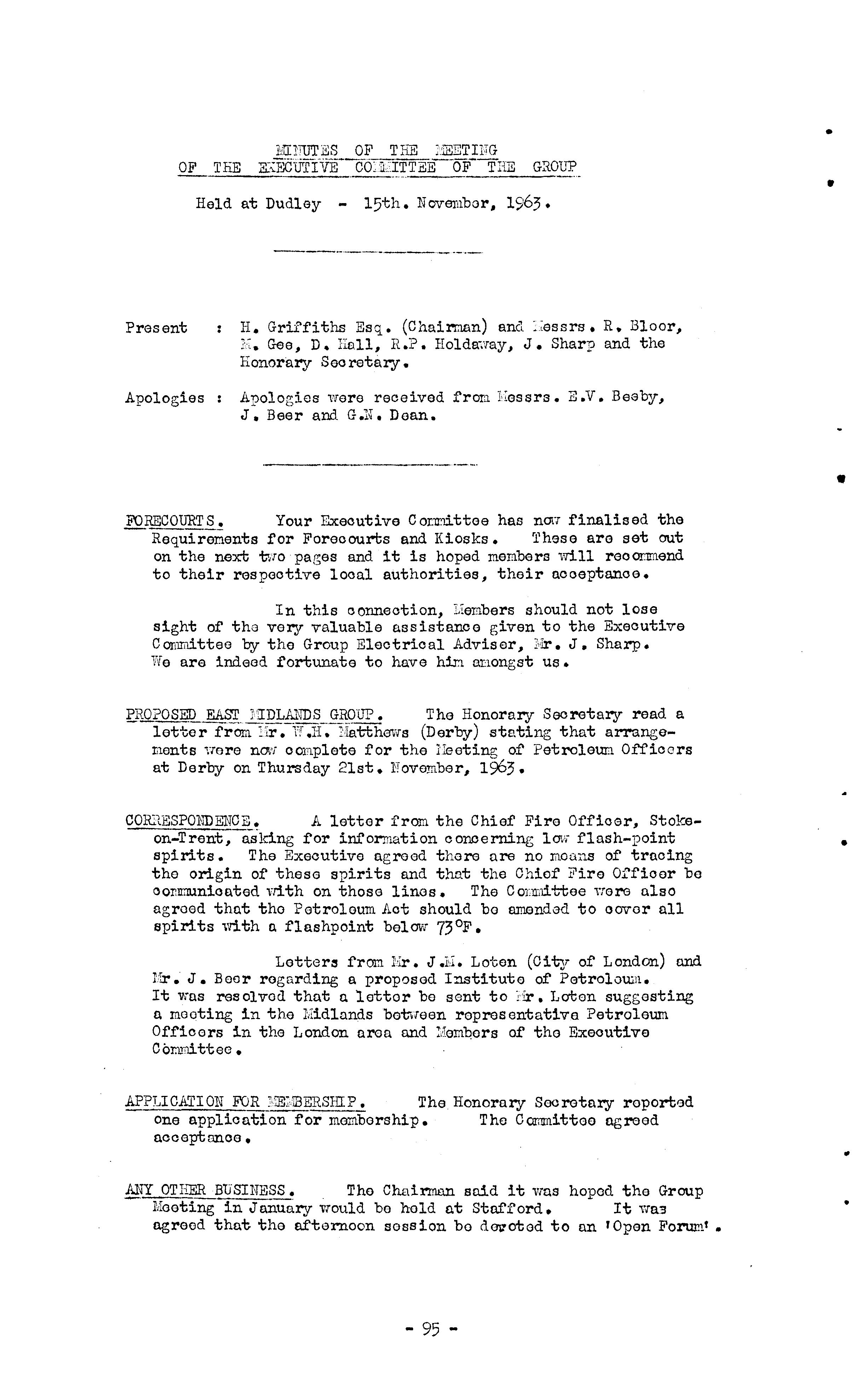
Apologies were received from l;essrs. E.V. Beeby, J. Beer and Dean.
Your Exeoutive CoDrJittee has nor.r finalised the Requirenents for Foreoourts and Kiosks. These are set out on the next 't;t;ro pages and it is hoped members "viU reoorrmend to their respeotive 1000.1 authorities, their acoeptanoe.
In this conneotion, I'lembers should not lose sight of the very valuable assistance given to the EJCecutive Conmuttee by the Group Electrical Adviser, Mr. J. Sharp. We are indeed fortunate to have hin anongst Uf;l.
PROPOSED EAS:L:.
The Honorary Secretary read a letter from :11'. TT .R. (Derby) ate.ting that arrange:ments ",-'ore nOli oOHplete for the Heeting of Petroleun Offioors at Derby on Thursday 21st. :lTovember, 1963.
COR:.lESPO:llDENCB. A letter from the Chief Fire Offioer, Stokeon-Trent, asking for information concerning low flash-point spirits. The Exeoutive agreed there are no mouns of tracing the origin of these spirits and that the Chiof Fire Offioor bo oO!:ImUnioated 'frith on those lines. The Conr;uttee vrere also agroed that the Petroleum Aot should be amended to covor all spirits ,nth 0. flashpoint belov.r 73°F.
Letter/! from Nr. J .E. Loten (City of London) and tIT. J. Beor regarding; a proposod Institute of PetrolO\liIl. It Was resolved that a lettor be sent to iIr. Loten suggosting a mooting in the Jadlands bot1reen representative Petroleum Officors in the London area and :Jemqors of the Exeoutive Cor.unitteo.
APPLI CAT I ON FOR }TIE:,mERSEI P-! The Honorary Soo retary roportlJd one application for mombership. The Committoe agreed acceptnnoe.
!E!Y OTHER BUSINESS. Tho Chuir:mun said it was hopocl tho Group Moeting in January would bo hold at Stafford. It wa::! agreod that. tho afternoon session bo dwotod to an r Open Forum' •
95 • • • • •
•
• 2.
PETROLEUM (CONSOLIDATION) ACT, 1928 INSTALLATIONS

1. Minimum Requirements '.Ni thin the Hazard i!.rea on Petrol Station
F'orecourts
(a) Hazard Area
For the purpose of these requirements, the hazard area can be taken to mean lithe area within a radius of 20 feet of a petroleum spirit dispenser or an opening to a petroleum spirit storage tank."
(b) General
(i)
more than 4 feet from floor level must be of flameproof construction. If more than 4 feet but not more than 7 feet from floor they must be of totally enclosed design.
(Exceptions; Tanker stands and vent pipes. numbers 2 and 3 below). See requirements
All electrical equipment, apparatus and appliances not (ii)
No socket outlets or flexible connections will be permitted •
(0) Kiosks and Other Buildings
Save in exceptional circumstances, where part only of a building is within the hazard area, the whole of that building will be classed as coming within the scope of these requirements unless there are no openings to that part of the building lying within the hazard area through which petroleum spirit vapour could pass.
(d) Wiring
I
All eleotrioal cables shall be either steel wire or steel tape armoured with a continuous metallic sheath, or mineral insulated copper sheathed. If above ground, cables contained within heavy guage, galvanised solid drawn steel conduit may be used. Where the latter is used, it shall be screwed into flameproof apparatus or appliances so as to engage the threads by the length speCified in B.S.229 (For conduits up to 1 inch diameter the thread length is lIt. Above that size it shall be 1 inch). A1l conduit joints shall be treated against the ingress of vlater.
Cables laid underground shall be at a minimum depth of 18 inches •
Tanker Stands
All electrical equipment, apparatus and appliances vnthin the area of the tanker stand, i.e. thirty feet by sixteen feet, and not more than four ground level must be of flameproof construction. Above this height and up to seventeen feet from ground level, they be of totally enclosed design.
3. Vent Pipes
The hazard area of a vent pipe and the requirements app,!rtainin g thereto are shown in Appendix A.
Neon and High Voltage Signs
5.
wiring, switches and other equipment shall be positioned and installed to the satisf2ction of the Petroleum Officer. The fireman's switch shall be positioned in accordance wiih the of the local Fire Authority.
Such signs and
Definitions and Notes
(i) The term "flnmeproof" applied to electrical apparatus means (a) apparatus which is certified to Group II standard by the Testing
•
• ..
-
Authori ty (the Ministry of Pov:er) in accordance v;i th British Standards Nos. 229 and 889, 3S appropriate, and which is l:Cj(lrked viith the Flameproof Certificate No? or (b) npparatus which has been approved by the UnderYJri ters Laboratories Incorporated, U.S .11.. , for Class I Group D. Hazardous Locations and which is labelled accordingly.
(ii) The term enclosod" aprlied to electrical apparatus means apparetus of an enclosed design c.nd fitted v'i th gaskets so as to resist the ingress of petroleum spirit V8.pour.
(iii) lis an .,1 ternati ve to flE,meproof construction, appe.ratus using
intrinsically-safe circuits may be used. See B.S. C. r. Ho_ 1003 1948 Installation and Maintenance of :F'lameproof o.nd Safe Electrical Equipment.
(iv) No time or other switches, cut-outs, or control gear shall be mounted in or on the base of the lighting cclunms unless contained within 8 flameproof enclosure"

Cv) The use of Division 2 "Lpproved E'luipment li will also be a.cceptable v,hen such apparatus has received Home Office allroval.
(Vi) Future developments in eloctrical 9.p:r;:aratus which may not IlJeet the above requirements viill be consid8r8d as and when they nrise.
equipment, a"paratus 8.nd upplhnces \\rithin the shaded zone shall be flameproof 0 Electrical equipment, ap?aratus and appliances outside the flameproof zone but within the dotted area shall be totally enclosed.
}
I I t I !
I t t
I
/ ",, I -- ,//'// t 11/1 / / /' \Vi // '1/ t / / ,I il / ,/' I' /! IJ 1 //l/' 1"/ I;' / / / t , f / / / l __ _
S
/ it : ' I _.' 'l_ / / // / / / /1 ! / /. ///// //1 //'1 {J lor<2 0 .----------?=I-71
97 • " • •
.b.P?ElmIX
FOR ELECTRl C;+ I AP?121i.TUS l>lID APPLI.A1JCES ADJACENT TO VEiJT (SEE REQUIREMEWr lIo. 3 OF CODE) •
Note Electrical
MrU1JTES OF THE llEEl'HTG -----". OF THE EXECUTIVE COlvlMITTEE OF THE GROUP
Held at Dudley 11th. December" 1963
Present Apologies
H. Griffiths Esq. (Chairman) and Messrs. Beeqyl Beer" Bloor, Dean, Hall, a.nd the Honorary Secretary.
Apologies '!;vere received from :,.Iess1"8. Gee and Sharp.
JOINr.r };1EEJ.'IlTG. The Chairman reporbed on the prooeedings a.t El. meeting of Petroleum. Officers from the East and West Midlands held at Derby. The West Midlands Group were represented iat this meeting by Messrs. Griffiths, Hall Holdrovay" Sharp and. the Honora 17 Sec reta17 •
Ho informed the Executive Connn1ttee that the following resolution Was passed : "That interested East Midlund Authorities be invited to join the West Midlands Petroleum Aots Administration Group, to be renamed t The Association of P<:rl;ro1eum ti •
Several mambers of the questioned the suitability of the title, and after oonsidorable disoussion it was proposed that the new· title ba 11Mid1and Petroleum Aots GrlJupll. This was agreed, and it was suggosted that this titlo be submittod on a lTul:iibe of I\Iotion to the Group at the AIUlual Meeting in April, 1$64.
Mm-WEEK SCHOOL SUB..cOlvIT,[c[TTEE. It was reporbod that the Sohool wuuld be held at Attingham-Park, Shrewsbury on 11th 13th. May, 19S4. Hoving in mind the otJroments made by studonts during the previous course, the Sub-Comm1ttee have drel'm up a syllabus which although outting out a number of permits mora timo for Syndionte discussions to take place. The report was approvod ond the HtJnorary Seoretary was instl"Uoted to dispatoh invitations to Local to supporb the Course by the 1st. January" 1964.
NEXT GROUP MEETDJiL. Arrangements for the noxt Meeting, to be held at stafford on Wednosday 22nd. January 1964, have been finnlisoo.
CORRESPONDID!CE. The Hcnorary Seoretary road a letter from Mr. J .M. Loten (London) expressing the desire for three members from the Lonclon area to meet members of the Exeoutivo Conrrnittoe rogarding a proposed Institute of Petroleum. A meeting has be en a rrnng od. •
A letter w-ns road from a Potroleum Offioer asking :tr the Group had issuod any recommendation regarding , storage of diesel and petroleum spirit in a double compnrbmetnt tank. It was agreed to reply to the effoot that whilst the Group had not mado un;y I'OCOIl!ll.<mdation oonoerning this typo d,f storage, the praotioo ,ros undesirable.
APPLICL.TIOHS FOR NlENBEESBIP. Two applioations f'or membership "Wore aocepted.
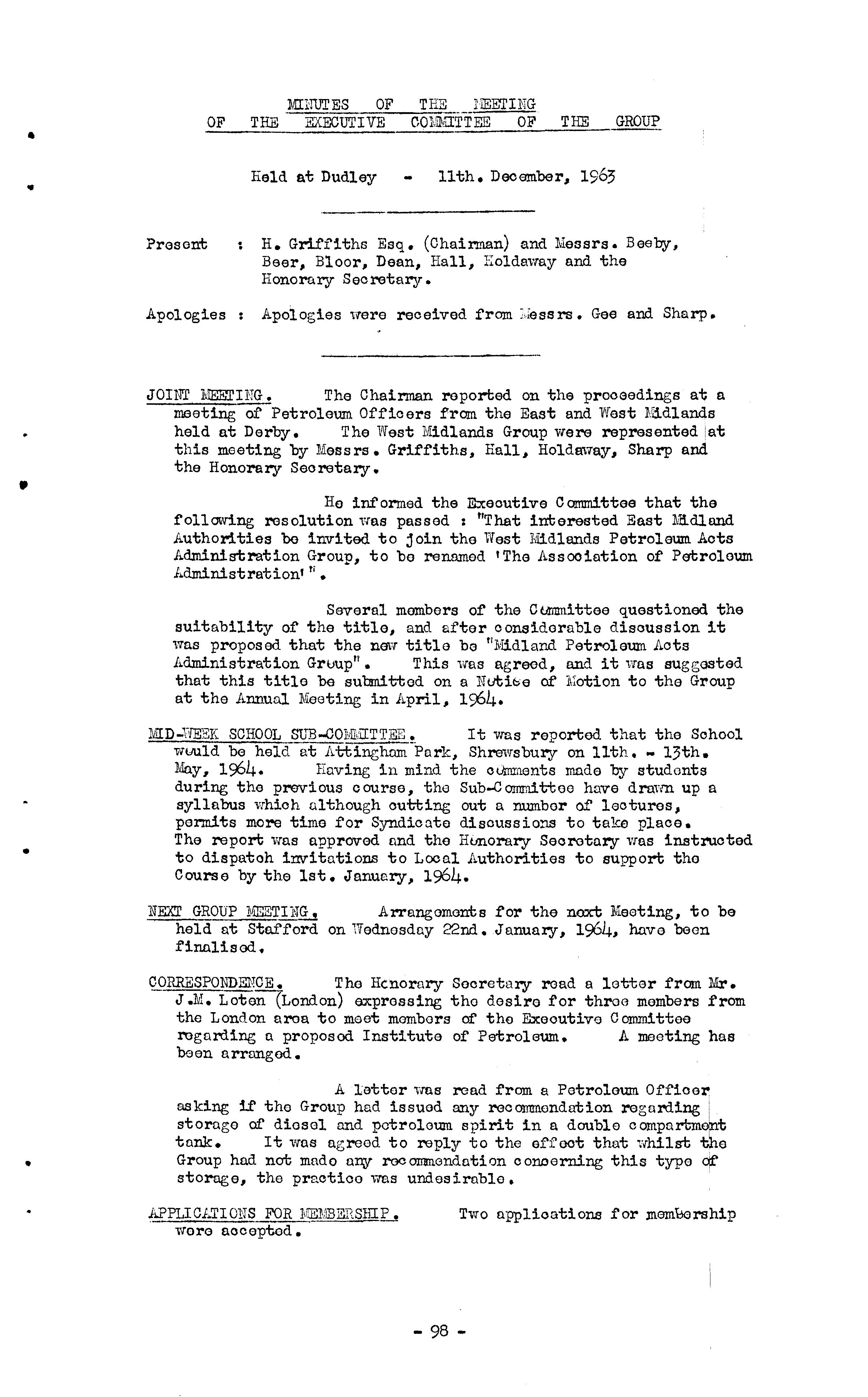
• .. •
•
•
98
A m;;otinc 'Jf tllo 'J.roup was hold .:'.t Th("; '. Shro".fr;bury on Hcdnoso.:,y 16th Oct ob:l', 1963. 'Illl,,::"t; '.'1orn 31 Loc:: 1 A1.1tho:ci ty ReprOFlont"'tiVGS 9 6 A1GOei:tE) 6 Tu:.lmiG::l Q1?icors 9 20 visi tors rncl I":.,'. B.J Q Slt'.ck 9 HOJ'lDl\,ry 14 ::Dolop;ies JOl'E) reocivud.
Tho Ch,cirm211 9 Er. H. Griffi ths 9 introduced The Jorshi:!'ful the of Councillor 'r.c. Bovld.lor, J.IJ. ?'ild invited hin to opon tho
Councillor B:wicller extendod to cleler;:::tes :'.nd theho}?G th·,t they WO ll,le', (mjoy t:!.r,ir visit to the historic of ShrowslJury. :k cOl'!(;r'ltulrctecl tho Gr:mp. :JrJ its lo.id OD1})h::1sis on the iml)ort;:nco of:,. hig;l st"'.l1..clr'.rd of enforcemont in ;::::?plyinG the provisions of the Pctroiol'Cl1 Act. Aftel' '\Jishi:'l8 the Group (1 succcs8ful ',1Gssion, ·'.nd sc:yine; h(){:mlcl. meet mombers c:>.t to,,- time 9 the of the meatins.
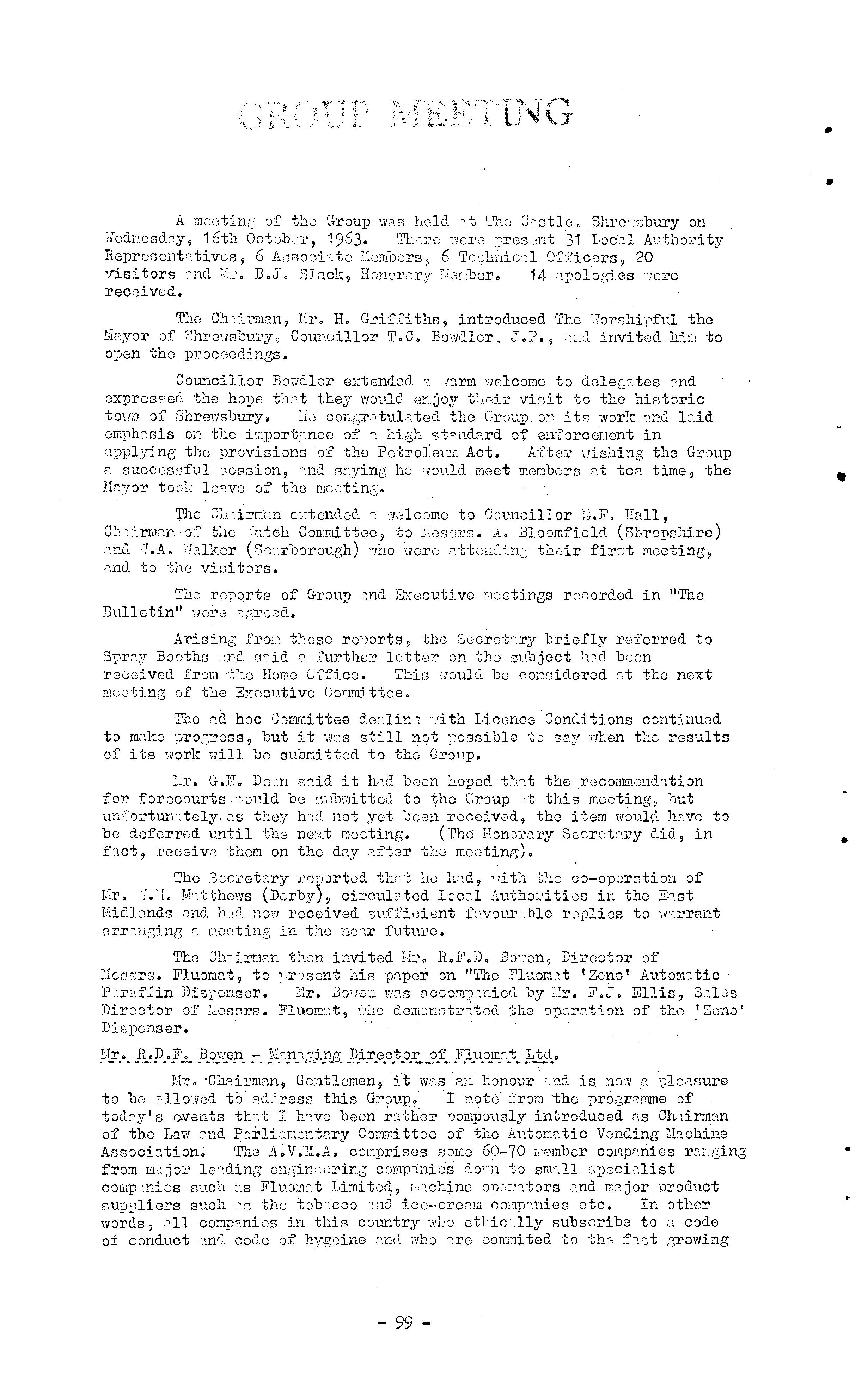
Tl18 c::tonclod [1 welc:)ffiO to C:J1.'11Cillor 1::;.:8', H<'.ll, ':If the Comnittoo 9 to HD'L);S. A. Bloomfiold. (Shropf:Jhire) .,x;.(l :7.IL ':1,:: lkor lx)ro1.'.gh) 'vho ;.vcrc Cc tlh:ir fire! t moeting ,·mo. b the visi brs.
The: of Group nnc1 Ex(:!cutivo ncetings recordod in liTho Bnllotin" Fci'c; ·-::').'8,-:;(1..
Arising fr:m thos0 rC-1)orts 9 tho Sccrct:>.ry bl'iofly roforred to Spr:.:.y Booths ,:no. s:-id C', further ::m 'ch;; oubject h:'c1 beon reGed vod fr:)m t'1e Ibme Jffico. This be conGidored 2t tho next me: oting of the ve Conmi ttee.
Tho ;:d hoc C:)i11"l1i ttee th I,iconc8 Concli tions ccmtimwd to proc,:ross? but it still not :;ossible "co s?Xiihen the rosul ts of its Nork "ill Q,,, submi tt.3d to the Group.
Er. Do en s:'id it h-,d: DOGn hopod tli·-,t the r()cormncnd'-',ti:m for forecourtS";::mld be [1u1Jmittoc1 to Gr:mp :t this but u;:dorturc toly .::s thoy 11::(', not yot beGn l'ocoivod 9 tho i "corn h"',vr:; to be doforred tL"ltil the mooting. (The Eon)r.::ry Sccrct;-'17 did 9 in f'!ct 9 roeGi w.') them on the d2Y ::-:fter thu mo(,ting).
The ,")':;cl'ott".ry J'rJIlJrtod tlv t hl" hod 9 'ri co-opcr::tion of I·1r,·:.:r. M'-cthc)1vS circu12tod Lec,l !·mth::;:·.'itic8 in the E',:st Llicll;__mds ;;no. h,(l n01" rocoived sl'.ffi.;ient r')l')lios to W'!l'rC"tnt nocJting in tho nO:1.r fut1.u'o.
Th8 tlecn invited Ih'. R.F.:;). Dil'cctor ::;f 1.lcD"'rs. Flu0n12t 1 to 1r::scnt his lx,-pCJr ::;n "'1.'110 Fluom,t I Zeno t Auto!Tr::.tic P .'r,=:f::Cin Disf·cnser. Hr. ib/CLl W2S oy 1:r. F.J. Ellis 9 ;3,LlS Director of Llcsnrs. Fluom-:t9 "110 of -cho 'Ze11.0' Dif;pcnser. n ..r ::. Ji;·:'.]-'l_'-3.iflJLRi.r_G_c_t_o£ .2LJ' .
Hro ·C112i::,'mo.n 9 Gentlemen, i't vns '211 hOn01.1r '':1cl is. :10W t". -ploc1sure tel bo ,,11 ::r.ved to qcL'.ress this Gr::mp, I l'1oto fr::)!'u the of tOd2Y'S c.v.snts th:-:t I hove hoen r:-:ti-;or J:l::>mp-:nlsly introduced ns Ch:--drm"tn of the p.-:rlL:r;1cnt.":ry Committee elf the Aut:;,mr.tic Vc;ncling i,bchi'l1e Associ::ti 'rho;\ V.fir.A. c::llnprisos 8:-1rDG 60-70 ."ombor comprcnies from EF jor le 0 dinG oC::;jin,;[)ring d:)")1 to sme:ll G})cci?list celmp'l1ios such :'S :F'lu:nn::t Limi I-l'cchino iJroduct 'tob 'cco "na ico-·cro.":L1 etc. In other words? ;:,11 comp:o.nios in this country wi:o otltie:lly subsc:ribe to n code of conduct corle of hygoine wh::> o.ro Gomrai ted to f'Oot growing
99 ... • .. • • •
'lnd incro?sing im;iravod vending i:'iold 9 1):)"I;h in I'ot,:::"l ':"!,:11os ::nd inclustri"l It h-'8 DCLl1 :'. plc:'8uro ,"n'.d to note h:J1v quic\:ly officicmtly ',:iur ('_0::1 9 1.1.ilo.:""'r '{our w:.t11 0 '; is ,:"'ni<:;o 88 -:011(: " d 1:18:;::'0
I '·,cm.Ll t::J cL'l ':.'i th:;Jlo subjoct )f VCJll!..l.inq; v':'!dor throo m::in ho:odings ;.:;c) :r e :>_, "'s it do,l'" with :)f j.ntoI'Gsto In ch::; ccm:::ic:.')T :::-,ct of :Wgicno? both wi tl:in tho ID'.chino '.l1C) '.8 it ·'.'::f:f,t c the T'1.J.blic. tl-·.is ".11 l""wmbcrr:< Qf :n.l.r Ls;:::)cL,tion C8i,tJ:'ilmtc; tJ " C::vJ(; of Hyc;imlO 'Vilicl!. is frC:0ly '.w'il1blo:nc1. 9 8:1 L,r Aut:Jnl'tic V·nclin{( in c::mcornod. is inclu2d :Co:'.turo :J? the .:;nc.1 :;n.ly '1. of concern '.Jhur,) wo pO:J"plG n'Jt to "cho m-:chinc ·,d to fC8d 01' vcncU_rl.,,"T,
S:)condly, t1Joro is the ':;..uostion 0f c:Jlnplying pith the ul1r'_or the \I8ights ,nd No:csnrof."J Acts? 19639 is gGl1err:l1y 3il1.cCl'oly welc'JmGd by ,Gombors of 'Jur !-i.ssocL:tion 9 for Aut:.m,tic V-Jr..ct:l..il[; JJi"od1.lCtS to Gold uno_or better CJl1.di tion3 th-'11 they c'Julct be s'Jld over the c'Jl.mtc,r. Thol'Gfore 9 to meot tho roquirer'1?:l1.ts of the AGt, in effect l'O:U::-: WG :'.re l)ublicising on tIle 'aG pcrfJrmo
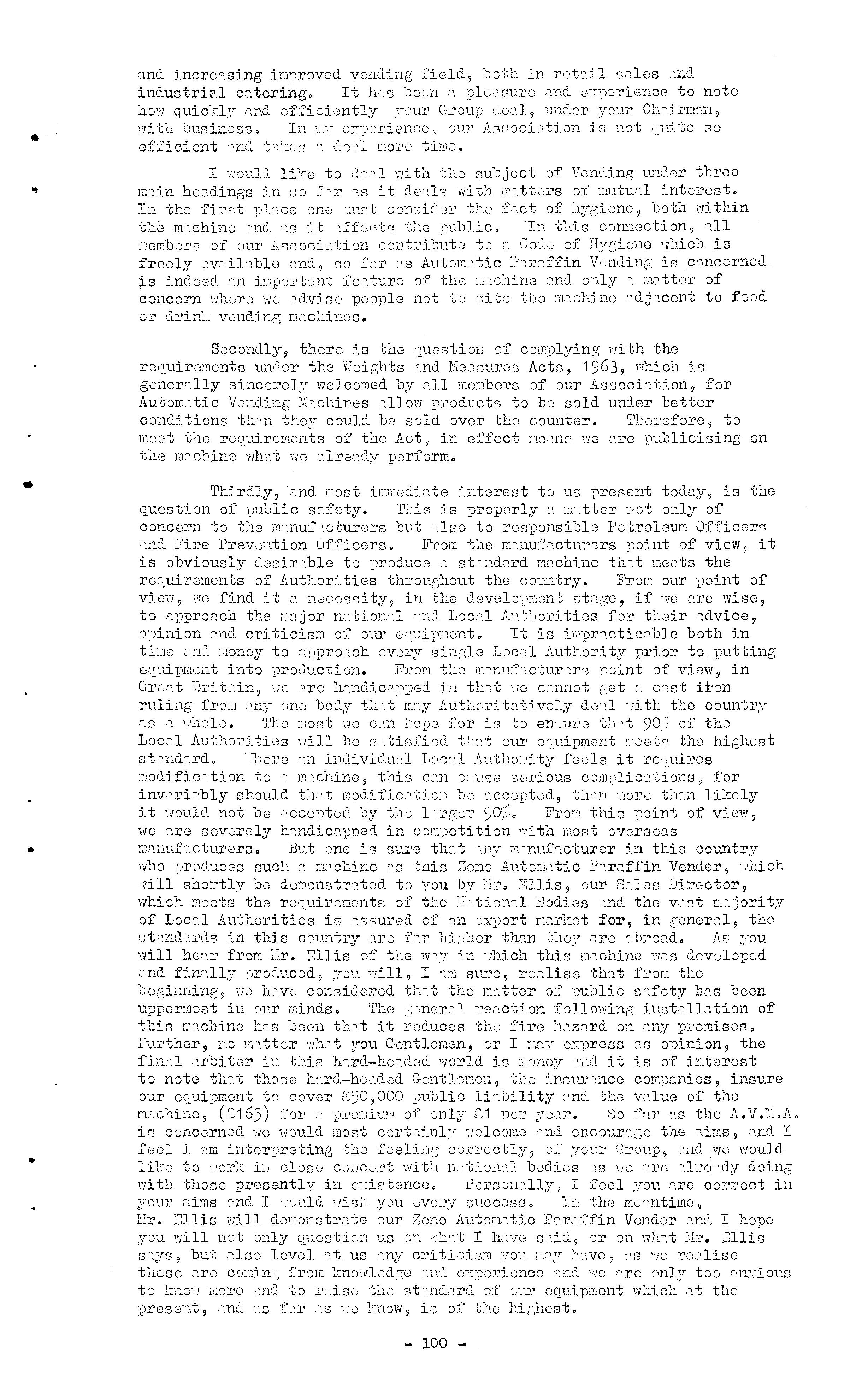
Thirdly? f'ost ir.1m" cli r:. tG intcrcst t'J us -pro sent toclc.y 9 is the question of IlU'ulic G2foty. ::;·ttor "'lot 'Jl:ly of concern -Co t}1.G l!'.:l:1u:C:cturGrs bllt to rosponsiblo h:. trolGurn Of::'icorn ,no. Prevc;'ltion Officers. From thc nC:"1U:c:ctur')rs point of view 5 it is 'Jbviously cloGir·.blc t'J :)roduce .:; st""'nd2rd mc:chinc th:'t meots the 8f Authori tics tho c:mntry. IJ1rorn our i10int of vim!? ;'10 find it .:.: ty? irl the cLeveloT':'10nt ct:!.2:C, if -70:'1'0 ',vi so , to 2ppronch the ffinjor for :y"inion criticism of our oc:ui}';;'.cnt. It is in:cgr-'ctic-oble both in ti:ne :lonoy to :::}pro ,ch cvory sL1C;lo Llc,l Authority ]lrior to pItting oCluipmcnt into l,r:xLucti :)11. Fr:lf'l m-'n''..f·.c-cnrc::r''1(,!()int of viGtv? in Crrc;.:t t,-'in? 'Ic'ro h:l1.c1ic'::PllGd i:.1. tl:.-,t '.10 c,:nnot C:Gt r' cost iron ruling fr'J!ll"'ny :,no boc:..y th:··.-c r:ry A1.:.t:"l:.·ri tntivo1y dO"l -.'ith tho coun·cry :-:El :::. nl1:)10. Tb.o [»::)3t C:- 1.11 I'Jr i:·j t:l"t 90',,: of tl1G LDc:-.l "d_ll bo r,-cinfirJcl.. ::lUr or:1-1_iIJL'lOnt noat" the bigxwst inrhvic;_LL'l k'c,l .i'l1.th:city fools it rc-,lliros to : ID::chine 9 this ouso sorious for inv '.ri·'bly should r'1odif:1..c· l·:; :ccc))t,)d, -che 1:l "1::)1'0 likely it ',oulc_ not 00 by th) 1 ':"'";':"(;:' Fl'or' thiG Iloint of viow? IHo:;rG s(')Vorcly h:nclic".lYDecl in wj)1rpoti tion '''i th j,lOSt 0vorS02S 31)_t ir'l S1..1.TO tlrt f''.cturer :1_n this country ·,ho T'r:1ducGs sue''.. ,: D.:'chino "s this Zuno Autonrtic P"r,:ffin Venclcr9 ':'hich ,!il1 sh'Jrtly bo dOl'Jonstr::tod \Tou lw El'. Ellis, our 8-1ofJ :Jiroctor, which moots the rCr".uil'C8cnts 8f tll.O : -,tioc:,,-'l Ibclios -:nd.. tho V''3t r,; 'jori ty of l,oc:::l Au-cll:)ritios is of ,n '>xpo:.."t for, in CC)l1er:,15 tIw i11 t11is c::l.1l'1try lli.",.llcr
GI'O 4) tri CK1.do -'7ill he:'r fr:)m Fr. r.llis of tlle w,,:-r -,hich this lll'chino 'V".S ()_cNulopod .:nd fin::lly :Jr::Khlcod 9 ;.r::JU ,','ill 9 I ..,c su:ro 9 r,::;.:liso th:::t f:C::Jm tho 11';v"c CJ11Si(JG}:-od tll''"'-G -tY1G 8f T?ulJlic g":fety 11.,::-'.8 been "LrpPoI'f'lOst iL 'Jur minds. 'I'hc. :nor:-,l r,,:.::'.c-ci_on fsl1owin{( inst:oll::'.tion of 11i 8 nr") cl1ino 11;-1,G 00011 tb.-, tit rOdtlCC S ::=il"G 811. I}I\}l11isc;s., Furthor, 1'0 Fl'tt:;r WJ:-L't you C-cntlomon, :Jr I !::'.Y opinLm, the fin'.l .:rbi tor i::. "'cd_:::: rcro..-hci'.cloc, lv0rld is l):")l1.cY:JiCl it is of interest t::; note th:'.t th880 h:-.rcl-hc·'.clcd "_PGUJ: -:11.co our equipment -CC! c:JVor ,000 })ublic iJili ty :'nd th0 ITl " ""l' 110 ((' 1,c:r:: \ -i"'''''' ')f' f' 1 •. :-'.--):J ".V':l 9 ,'''' V_}J .• '. J u c.... '-' ,,' _,.l 0
C0r-11X;nios? iJ1sure v::luG of tho the A.V.U.A. i:::; c:;nccr11.ccl -'vc wmld ill'JS-C cCTt-.:inl''- ';:OlC:lE10-·nd. th(" :-.ims 9 ".nd I fool I il1.tcr)rcting tho :i:'c:elil1{; C8Tl"C;ctly 9 .',T:)lC' Cl'OL:'P 5:\10- we r.'Oul(1 lH:"J -G'J L"! close; C,),lccrt with n bodies '.S '!c::rn .... L:o·:dy doing rli tl; those presently in :t'o:c;:;:';lP11y; I foel ;TJn ccrj:'oct Ll your ;-:ims :::ml I ,',.,,-,10.. l.fiF,::c .yY,1 ovor.? r:mccosso I::'. tho mc""'ntimo 9 111'. mlis ','!ill c1u r ':)l".str:'-co ::Jur Zen':> Autom.'.tio P"r:_'.:Zfin Vondor m1- I hOllC "I,vill r18t D111y Qll0Sti:--,:1 t18 I G'.id 9 8r 811. I.";'}l,:.t LIT'. s·:ys 9 bU.t ,"-,10:) lovol -.:.t us ·"\.n:l cri .:T81'_ 9 :'.8 rc-::liso thosc:ro fl':'ll]1 lcn::J.v1oclr'."o ':l: r'_ O':')c:eionco t::'8 ":YlXiOl.lS t:) k{lO'! l-lcro,11.cl to l'-'iSG tl1\; st'nQ.:rcl 8f :::,"l:2' oq1.1ipmont w::.1icil 'et the
• lit • • •
100
Bcf::n'() (;i vir: r: the tlOffic)l'J,fJtr-:tion I 'J()"1'1(1, li:'<:G to oxpl'in the procormos wo .JoY',':; thr8ugh l)c:"::>ro !:rd'c,.-,::i.n?; the Dl,:chinc on mr;rket. lI'vinr.; :)vcr till) J11':cic.ine :m rJoClrd. of Tr::cdo 1313 ", prototype '1:'.8 lJUil t sc:fc/C3r f.c,c:tv.ros. Hc·ving no n:::tion"ll bJrly t:" ,,'pproC'ch 9 t:i.C ,.'cic)\tn :":ld ,-:l';.d Fire Frovonti:m Depc:rtT:1cnts B:'istol ',Iore i::ivi tod to voice 'cheir c:ri ticisms. Foll'y'/in.', t1:is, tho DC;lx1rtmont of the l<l:', cling; CJil Comp:lllios :--.81:ocl to vJicc Gl;i:liono 9 :',18 lJuil t tho 2.8 you S08 it
Tllis :1.11 li'":8811 ti1 the Pctr:)loUID Don,rtmont of tl10 L.C.Co'nd. the 'JI rrr:'de. The 8f Tr',dc h"vin;; ias'.1.eQ their Loticc 0f ti 1358? '10 ,ls:) received c:p;:>rovnl :"'.UO. :roc:);-,1;)}end",tions ,:)f fr::>m 'Jil c:Jmp:.:nios ,',nel EJ:-!lG3 ·::rG m?dc t1."!..QS':::'; 8111y.
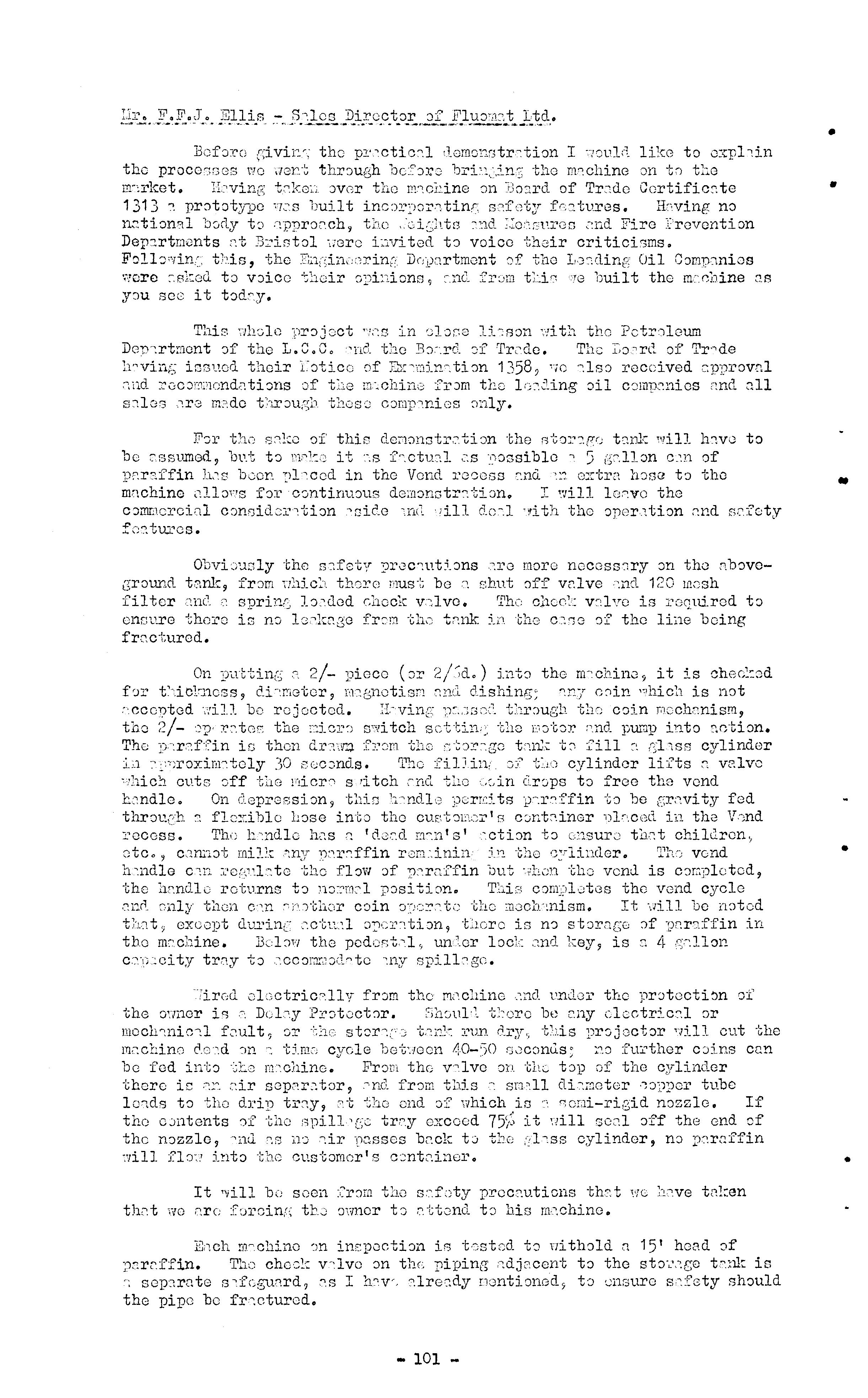
F:JI' tJc.., 8::1;:0 (If thi8 cLC:10n:Jtl',-:,tion the GtO}''2{!r; tC11'J1: will h:1vO to be :::'f:lSLUnod, fJ1.'.t t'J P1;:->',-:::: it '-.S '::s '"ossibl0 ., ) g:--.118n o.:n of boon ,l,cod in the Vend rocoos oxtrn h'Jsa t8 the mrcchino ,,1101"8 f'JT c:mtimD1.lS
I ':Iill lc,':vo the c:)):nIncrci'11 c:m'Jidcl"ti'Jrl "'cic.e ,nl:.;ill 0.0"'-1 ':ri th tho 'Jpc;r:ti:m sefoty ..J:'cs.
ObvL),'J.:Jly tho s-::fcty YI'0C:ut:i.8ns ."1'0 moro 'In the :cbovolsround t,:mk, fr8m Tlllic:'-, bo :, f:;hut off v21vc:ncl 120 w;)sh filtor:mr'. ::: sprinrj 10,'dod chock v-::lvo. The vr,l,.ro is l'GC]lli.rod t8 on::::ure thol'O is n:; 18,1\:23° fr::r:1 -Ch;:; tr:nk :i]l tho C::'jG 'Jf tho 11110 boing fr2cturod.
On yuctinc; .:c. 2/- lJioco (Jr int:J tho nr'C.l".l11G 9 it is f'Jl' t>ich1CSS 9 C.i"l"iotor, ':r.:T cC'lin "'hicll is l1C)t :·cce1jted ·,!iJJ. bo rojoctocl. ;I.-vinr t:1r:mgh tly; cain f.1ochC'nism, the ;?/-.;p, :r.':'.tos the El'vi tch scttin;., tl18 U:.1-G():r.' ;0 no. pU1TI}? into Tho J):r2.f?in ifJ thon dr::;\m the; t'm::;: t:: :fill (;1,88 cylinder i:.1 :' :."Jroxim:toly 30 8cc:mds. 11110 fil}il1(,)? t:J') cylinder lifts [' v21vo cuts 8,ff tlw Flier', S 'i tcn :-ncl tLo,:,in CLrJps t8 froe the vend l:::.::ndle. 011 c1.opro8sion 9 this 1'l'ncll,3 :rr.r-:::ffin to bo ("r;:vity fod thro'L'.ch flc::dblo hose into tho s c:;r..t:-inor ill the V:md Th,) l::ndlo h.:cs .:;, 'cL:;C'cl Ern's' ta tl1-":t chil0.ren, otCO? C·.'ffil'Jt miE;: ."ny 1;:'.r,ffin rCf·Linin :i. 1":'. tho c:,lLl.cler. 'l'l,.'; vend 1'1 --.ndle C:D. 'che flQW Qf ;:J:'r"ffin but '.,;Lem 'cho von:1 is cor::pletcd, tho h:;nu.lc rottl.rnc t'J 11::c[O:,l p:.1si ti::m. cJn1)l'.JtGS the vond cycle ,:1':r1. oA11;y c"n coin the :u3c[J::nism. It ",ill 1)0 n::>tod. t}nt, Gxcopt c.lu.l'il1C.:C-Gl'..-:l is no st::lrnr;G of in the m::.cJ::ine. the pedcst'l; un",or IJcI: ::mc1 l:ey? is 2. 4 .-:-;-:110n ty trrlY ·G:J'.CCOl'J!",;:xl 'cny spill:, gc.
:irc,d oL,ctriccll y fr:)ffi the l'11Q'31' tho ai' the o',mor Dcl'.y 21':)toct:1r. mlJlll·:. t>cro be 2ny or meckmic:l f:ult? Jr stor-o,:-:; l'1Ul (1.1'3'" t1),is l)rojoctor 'JilJ. cut the cl,sod t:i,m:; cyclo [)(/C'.!OOl1 40-:30 G,;ccmus :".0 fUl'thor c:Jins co.n 1)0 fod into 'cL::: mcchino. Fr:)))l thQ v'lvo::n.l. th.:. t:.1P of the c3Tlincler thoro ic :::". sop:"1'.::.tor9'nd. from this --: sDcll CLi.:;'!lotor tubo lOi.d::; to t}w drill trC1Y, :,-1; "):10 cnd ::If which if.) ,., rwni-ri,sid nozzle. If tho c.:mtents -che !:;pill'cc trry oxcood :Lt ',!ill 80:1 ::Iff the ond of the nJzzle, ,8 no ,ir pnssos b2ck tj tbe n:; p:rnffin fIe)':.' hlt'J the customor's c·:;nt2i:18r.
It 'viII bc; 80011 tho s.':-.f;)ty proc2uticllS t "le t"bm th"t wo ::ere f',Jl'oin,r; tr,:; awnor t:) ::.ttonc1 to his m:chino.
}ij;,ch m"'.chino rm inspGcti'Jl1 is t:::stcd to ni th81d [\ 15' heRd 'jf Th() 8n the Diping ,:.dj2cont t'J the St'J'L,,;gO is -; sop-::rntG 8 ,fcgu2rd 7 :,.s I h"v-, :::lrec;dy Donti8nod, t,;) '-.:118urO s::CGty should tho pipe be fr:cturod.
101 • • • • •
The m,'chino ,:nu ',vill soo n:p::m 0'C"E'ii'l 'ti is str:mgly tho Yloocssi t'( :cor simple cus-GJn1or J,!cT2ti:m inv::; 1 vod consiCtcrblo tb::mC:ht in dosigncj1(l, tl:"o::mtrn::rd "'J)::!c:r:;11.CC i8 9 '.10 fool, ttr:-:cti •
DISCUSSION
Hr. D. Ikins';v:)rth 'llokl Oill'r:)(lucts (C·.D.) Ltd. Ur. F.F.J. tiT. R.D.F. Bowon lir. R.D.F. Boryon H2'• J. Trir:1ii]
tllG flo::iblo pipo bocrtmo clifJ..:mf,2,,",:od fr:m tho rocci'ling- recoJ)tnclo 9 -;dll tho surnp Lllc1 t!W sllill!:' ,100 Yos, the ;; of 4 t/:1Lms 0 )0 h"VG triad " 110':1 by cro'ctin'" '::n cdr tr::p in tllO me2snring Q::Jtt1o :"11<.;. s}lould the snilL:go tr<'.y boc:)mo £, full, J)Ctrccffil1 1/il1 not c:mtinue b be dis,[)onsod •
IT tlo··unrlor-Lymo. JiClhe;d to ImJw h:),1 'o'ould tho s}lc:'.kors recommond tb; cli8post',1 of spi11,"'e;o. R;pliod thoro ',-Iore t',IO ]:norm ·':::.ys of o,isposo.l. Firstly 9 by c;lptyint'; the int:) ?, V/2ste b'?rrel 'nO. Sdll in,'; the; c:cc',u,n,l:c: ted p:rnffin :ply. 30condly, t::; usc i t for olo,:-:nin.:; pUrp8GGS.
i tho tr2Y dlso li:-.."o10 to c::.l1oct ::'slcod if:::ny boon given t8 fitting c cbublo c:)r,11):;T-C!nont (l.riD -cr:::.y -:i th: grid fil tor t:; ttlO -:rl.d
thoy
fitting such Q filter "out ::8 :1." j_':1rr' tor? p2por w'Juld :18:) be :Jl')i·m intJ the) tr:lY"i"J.cl. DF'.y v;)ry 1"'011 b1')0l:: such:: filter. C8nsoqllOntlY9 :!l1y spilJ. -,?O '.'iJuld flew; -(;8 the :c'8rcc-::urt ::Jr fl"::mt. Iris fol t inntrtY;-ciJns pi van 'wi th the for it t::J bo 010211.0d rogul::rly, 2nd ti:e fre(LuontlY9 woro ,:"o.oqUJ.to. ;)J.lOll-!"Iex ::nd 13.P. Ltd. 'T.';:lt:;d t:, Im8\l ie: tlJ.GTO ',J:::O ::ny 8Crm'l fj.t·sGci.. tb.o porsJn to oxert ::;xtromo rrl)8Sl'.re ?"ncl':cI:J J wore thoro 'my <"dfficul tics cvic1,cnt '::i th the :,lr>,s-cic very 218S0 9 ospc;ci21ly cl1.11'in.s: cole: i7Cntl10r. 'QuId. it fr"cturo? i;::vjt':mco?
Jbpliod t:1U
'.Ji th.'3tcmd ::1 pro!ssure of 1 3 them shc::1r 9 thUG proVenting ,n:," intern:'.1 cl,c:m<'.c;o tJ tl'lc mcch""1ism. Tho m-:cllino must h :'10 ::1 pli:--.l:ll0 h::.>so·s it h='8 08011 f:')tmd thn.t ::: :::'igid t:':!O 11:)so is li:::blo t'J f!'[!cturo. Thoro w"s, ho in Die of production::: thin wi:;:'G :,1,)s11 };1 'stic bo inpcrvious t:) tompol'·turo on. 9 :0 riGid food :Ii:',o w:Ju1d be the c:Ylf:\!()r tilio W2S impr;:ctic::colo (hw t::; tho:Jido v-:l'ioty :)f c:intC'inors in uso.

• " • • •
102
1':1". J 0 Boer Ur. R.D.F.
;-j t ')1\:0- :m-TrGllt. It- 8 t;.:.\) :--. cif '-'.J.
.:-l.:-J-G Di"1I':; st.:.tic? 'Cll0 i tsclf
?1 lX)il1.t ')f v'"'sL":l' tJO :liC;h to prGscnt
Is of t;'18 :Y:r.:1fz"i11 :j\/"Cl"t tl},:: -ChI":' h:>S8. 7:,8, l,)llt 5_; sq1.i.il'"'ti11P; tllO llQSG tIle ..)f' trtc r.n ;C11t110 '1 tI18 best rc:J.ccly f:)r tI10 1(i.1v",
t;rt tho Gl'JUp '.10:;:'0 rJ.ot inf.:::vour of vo:-->(:1.in::_, !11:'.c;'inos f'::)1' -cho s -10 ::.>f l)Otl'ol, r)1ct ':v')nQcrc'd. j.f -;:c ';1'0 -:q t11.C 'I'lC'.Y t8 "nother ;lctr::.>l 81100
I ,·}:)tlld li::.:;.; t·J r:::::'/' ;:rcs 9 ·hllt tecn.:-lic-,l '.I::.>rk ,Yot -G:) (lO rrhG T):)ij:lt is tll.1.t did no';; '.llT.' v,;:,:clin,':;:L(] no l;;-'ll1.',:'oturer \F'.:.!· g'.)in,c:: t::; L:y :nXG 1-:1':;0 :1mount of c".ri t:cl on o.ovolopmcmt no,! 18(:'}.i31;-tti::m :-:sSlcrwl :] CGto Solihull.
:;::':.J.!.:min(r, the; l"-;-c TlcostiJl1" e·:n D::cb.ine be fuel of }.lO 0 "I'Lil8 eJ.CYVG 1 Jf ,,"" fQ:;:' dis i;J =::: -bl-lt t:l0 D:;tC-:.-:ts ::J:? ;·Q;:"lil1.G q it 00 usod far '; c:n;r linllicl.
lire R.D.F.
vnlve c;top ,):(' of ·C-,-l:.'"'; -'rid It""· i711Y 112.t1 'i G'::)cci c'11Y--flon S1..ccJ, Ll::-I";,,11,c,ti::l1,- j.G inda::.>rs. 8 i s l.1C:S t i :J.; of e 'T'}lG 1 c:n.:1Ifl cJiY:I'::'nies fn11 rc::rp:msi1Jili ty rcg,-:rcling
rl:-C o ;Jprl1cti11g·:'1 I:F:cb.oEo 9 C11:i_c;f !:-'.;.r:DG t:.: his

103 • • .. • •
"§ELF SERVICE IN THE RETAILIl'lG OF PETROL"
R. G. SPALDING, A.M.LEech.E. Chief Engineer, Hayne 'rank &: Pump Co., Ltd.
In this context, self service is a generic term all the varieties of which involve the customer in making the actual petrol delivery into the motor car tank, himself. The variations are concerned with the equipment used and the methods by which payment is made.
For example, payment may be in advance, by inserting coins or tokens, or by paying a cashier in attendance. Alternatively, payment may be made after the delivery as the customer leaves the service station or, some time later, by various types of credit facility.
Self service can be divided into two main categories, which might be termed emergency service and full service respectively. Emergency service is the means whereby the consumer is given an opportunity of obtaining goods outside normal retailing hours or in locations away from established shopping facilities. This is best illustrated by coin operated automatic vend:ing machines. In petrol vending this type of service would be aimed to protect the motorist against being stranded during a night journey or to refuel in some remoter parts of the country, where at certain times of the year it may not be economical to have a manned service station. Such outlets would probably be designed to dispense comparatively small amounts of petrol at each delivery, 8S distinct from the alternative fornl of self service, namely full service, which would be arranged as a substitute for the conventional service station.
There are many problems involved in producing equipment to satisfy the various requirements that have been put forward to manufacturers. Not the least of these is the development of apparatus which is completely reliable when used by the general public. In fact, the only way to develop such equipment is to have it used by the general public and observe and act upon the results.
This involves field tria.ls, and whils toil compa nies and service station operators are ready to co-operate in this direction, there is a reluctance on the part of local government authorities to have an.,vthing to do with experiments of this nature.
The next problem to be considered is the h11.'1lan engineering aspect; or as the Americans choose to call it, the science of ergonomics. Some of the factors involved in this are fairly obvious, such as the variety of physical characteristics of human beings, and their ability to rGad figures and instructions and to operate controls. This aspect has an added importance} in that it bears directly on matters associated Vlith making the idea of self-service attractive to the customer and indireot1y on matters concerned with safety in operation.
The final problem to be referred to is that of safety itself, and this is the one which is of most interest and concern to people concerned with the administration of the Petroleum Act. At the moment, it js probably true to say that safety problems which might arise with petrol self service schemes are to an extent, hypothetical, since there is no first hand experience to go on. The tendency, therefore, is considering the safety' aspect, is to'assume the worst.

• • •
104
Historically, coin oporDtt!d PQmps were holing installed in this country as long ago as 1923. These were hand-operated pumps which were clumsy to operE.lte and not 1.-lholly reliable, mechanically. As far as is known, they never gave rise to any hazard and although SOllle were used almost up to the outbreak of the second world \"Br, they eventuCllly became extinct.
Sweden has a long tradition of self service, particularly with coin operC!ted petrol/oil dispensers and with the post payment type of self service concept.
Holland has permitted the use of coin operated petrol/ oil dispensers for SHverDl years and, as in S'.18den, these are allowed on unattended sites.
Progress in the United States of has heen very slow and is probably on a par with that in the U.K. at Berlin, Maryland, there is a completely unattended station. with coin operated pmnps, and more recently coin operDted pumps have been in the Chicsgo area to test the validity of certain Federal laws which have prohibit8d their use.
In the past, Germany has adopted much the same attitude as this country to self service, but within the past few months at least one coin operated model has been approved by the German authorities, for unrestricted installatioI'. in that country. One major oil company has already announced its intention of turning over one third of its outlets to this type of vending early in the new year.
In Belgium one oil company has brc:·en operating coin con ... trolled pumps for emergency service for about the past two years. These give a fixed delivery on the insertion of a hundred franc coin.
Finally, Australia is perhaps the r.1ost interesting example, in the sense thet in that country the rather rigid labour laws enforce the closing of service stations at the same time as factories and other industrial und '3rtDkings. To enable petrol to be obtained from the lat.e afternoon onwards, coin operated pumps are permitted in most parts of Australia.
Quite recently, with the co-oper[;tion of the Chief Inspector of Weights and He:::sures, ;md the Petroleum Officer for the City of Manchester, we have installed in that city, a coin operated petrol pump for mec}wnicel evaluation and also to test the reaction of the public to this type of equipment. The conditions under which we were permitted to install the plunp included a stjpulation that it would only be used during the normal operating hours of the service st8tion. It was installed at the beginning of August Dnd the latest report shm"s that it has performed perfectly from El mechanical vim.Jpoint.

To obtain delivery from the pump it is necessary to insert two half-crowns in the coin slot which is on the opposite side of the pump to the hose. 7hen the nozzle is removed and the combinod switch lever and noz:de support turned anti-clockwjse. The nozzle is placed in the car filler tube and the trigger held open until the pump cuts off automatically after a preset quantity of five shillin@ worth has been delivered.
Points of interest are that the coins cannot be accepted by the device unless the st,li tch lever is in the off position, and the motor ccUlDOt be switched on until the coins have been accepted. The switch lever cannot be turned unless the nozzle hlJs been removed and the nozzle cannot be removed with the trigger lever being a ccident:311y opened. The nozzle is of the automatic type which closes when the vehicle tank is full.
1 0 5 • • • • •
A further machine has been developed and is undergoing 1tlOrks testing, whereby somm.Jhat larger amolmts of petrol can be obtained at each delivery and 1IJhore the 'customer is, to some extent, giv(m a choice as to how much he can obtain. This coin unit is to accept any number of florins up to a total of ten, to add them up and preaet the pump for the required amolmt. All the other controls and operational sequence are the some as for the pump installed at }1anchester. The coin unit is a modification of that used in G.P.O. stamp machines and is therefore extremoly reliable in operation.
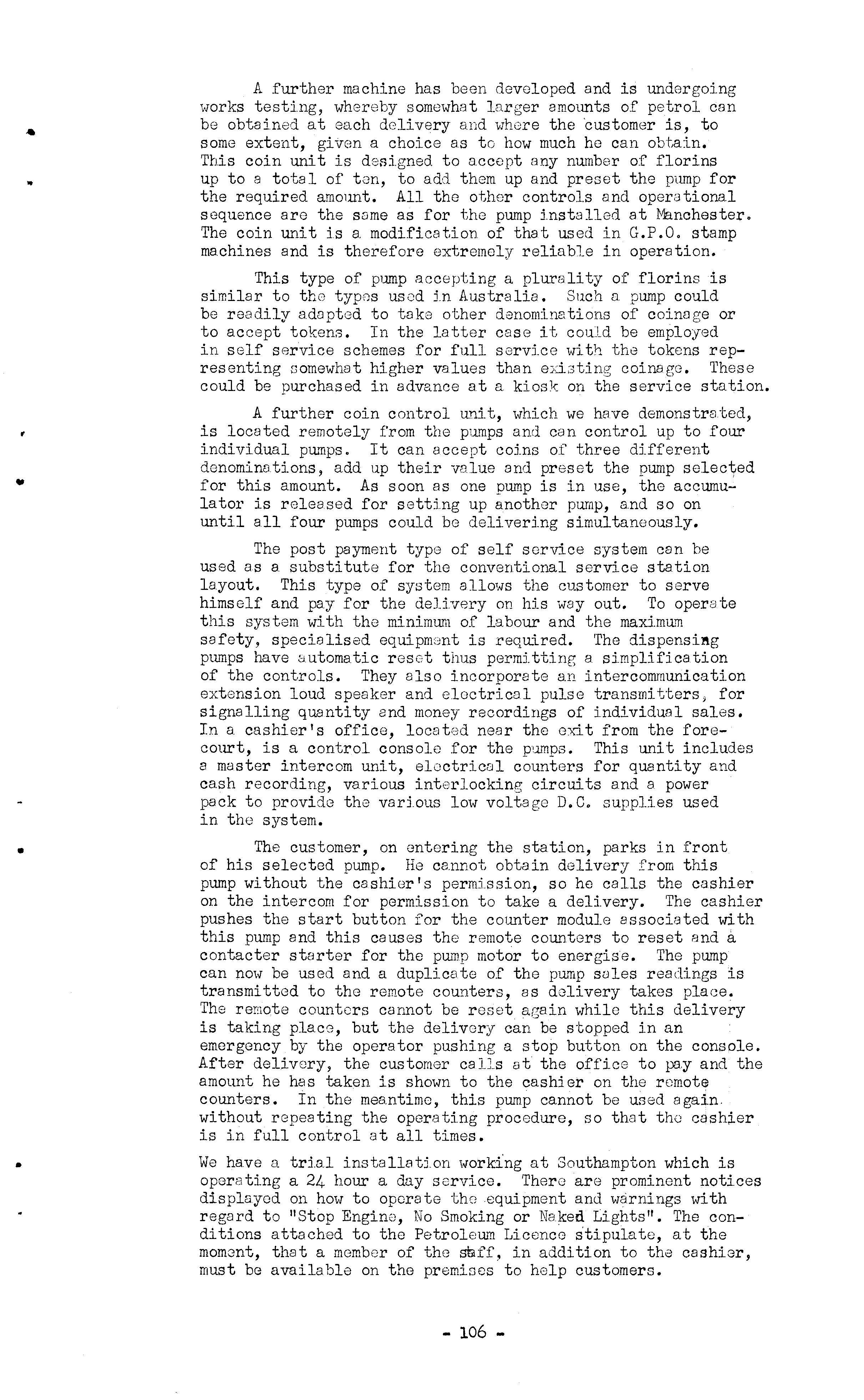
This type of pump accepting a plut'[3lity of florins is similar to the typ8S usod in Australia. Such a pump could be readily adopted to take other denominations of coinDge or to accept tokens. In the latter case it could be employed in self s8rvice schemes for full service with the tokens representing [lomewhat higher values than exi3ting coinago. These could be purchased in advance at a kiosk on the service station.
A further coin control unit, which we have demonstrated, is located remotely from the pumps and can control up to four individual pumps. It can accept coins of three different denominations, add up their Vlllue and preset the pump selected for this amount. As soon as one pump is in use, the accumulator is released for setting up another pump, and so on until all four pumps could be delivering simultaneously.
The post payment type of self service system can be used as a substitute for the conventional service station layout. This type of system allm.Js the customer to serve himself and pay for the delivery on his way out. To operate this system with the minimum of labour and the maximum safety, specialised equipnunt is requJred. The dispensil\g pumps have butomatic reset thus permitting a simplification of the controls. They also incorporate an intercommunication extension loud speaker and eloctrical pulse transmitters, for signalling quantity and money recordings of individual sales. In a cashier's office, locat,,"d near the o).'it from the forecourt, is a control consolo for the pumps. This unit includes a master intercom unit, eloctrical counters for quantity and cash recording, various interlocking circuits and a power pack to provido the various Im.J voltage D. CD supplies used in the system.
The customer, on cmtering the station, parks in front of his selected pump. He cannot obtain delivery from this pump without the cashior's permission, so he calls the cashier on the intercom for permission to take a delivery. The cashier pushes the start button for the counter module associ!3ted with this pump and this causes the remote to reset and a contacter stnrter for the pump motor to energise. The pump can nOi-l be used and a duplicate of the purnp soles readings is transmitted to the remote counters, as delivery takes plaGe. The reElote counters cannot be reset again while this delivery is taking place;, but the delivery can be stopped in an emergency by the operator pushing a stop button on the console. After delivery, the customer caEs at the office to pay and the amount he has taken is shown to the cashier on the remote counters. In the meantime, this pump cannot be used again, without repeating the operating procodure, so that the is in full control at all times.
We have a trial installation i.Jorklng at Southampton which is opornting a 24 hour a day service. There are prominent notices displayod on hm-l to thoequipment and w[jrnings with regard to nstop Engino, No Smoking or Naked Lights". The conditions attached to the Petroleum Licenco stipulate, at the moment, that a member of the seff, in addition to the cashier, must be available on the premises to help customers.
.. • •
106
Developments in hand for post payment self sCJrvic,3 systems includi'3 [3 remote pres()t to simplify sUlI further the fwnp
This device could equally be: used in a pro-poyment self service E.lystem where the custom8r peid 8S he entored the station and tho cashier Clot up tho pump s(,locted for this amount, by romote control.
Looking towards the ultimDto in self serv:ice, namely the fully 8utometed service station, certain f8ctors emerge which are beyond solution under existing rcguh:: tions. For oX3mple, the conditions ElttclChod to petrole1.Ull liconr:::es include provisions that cannot be onforc.Jd on an unmannod self sorvice pump. 'I'he conflict may best bu summarised by quoting some of the conditions recently Guggest,3d by Authori ti(;s os El re::mlt of the jntroduction of self service instollations and automDtic nozzles into this country.
With regard to potrol/oil dispensers, your Group have recommendocl the followj.ng:
Any instru..ment must be sited at least 20 feet from a Public right of way and out of reoch of 'mischievous persons'. Specific approval must be sought for each instrumont. The licenso8 must also ensure among other conditions thDt the instrument is under lock Dnd key when a responsible person is not available to see that it is not improperly used.
On petrol dispensers cm IJutomatic n0'6z1'3 must be fitted and as alrGady m:.mtioned, en post payment self service sta tions, staff should be a minimum of two and suitable emergency drills should be practised.
The Homo Ufn co [1 re 0Ppos Gd to la tches on a utoma tic nozzles on the grounds that cut-off is d::::pendent on petrol velocity through the nozzle, and the nozzle vlill not cut-off immediately if it falls out of tho f:: 11 pipe.
The petroleum pDnel of the Instituto of Weights ond Heasuras ,'3dded theso furthc:r stipUlations. Children must not be ob18 to get petrol from tho instrurnc:mts; the instruments must be so sited as to croDte 3 minimum hazard in the event of [1 spill, which should run away to an intc;rcoptor of suitable design; they must not be opol'clble unloss tho customer has a special [is WOJ..l_ as money- the A.A. box key WDS snggested; a safety device should be incorporated to prevent delivery unlesi) th0 nozzle is in the filler of tho vehicle; it must be impossible to lcavo the nozzle lying on the ground; they should be restricted to on8 per garag::;.
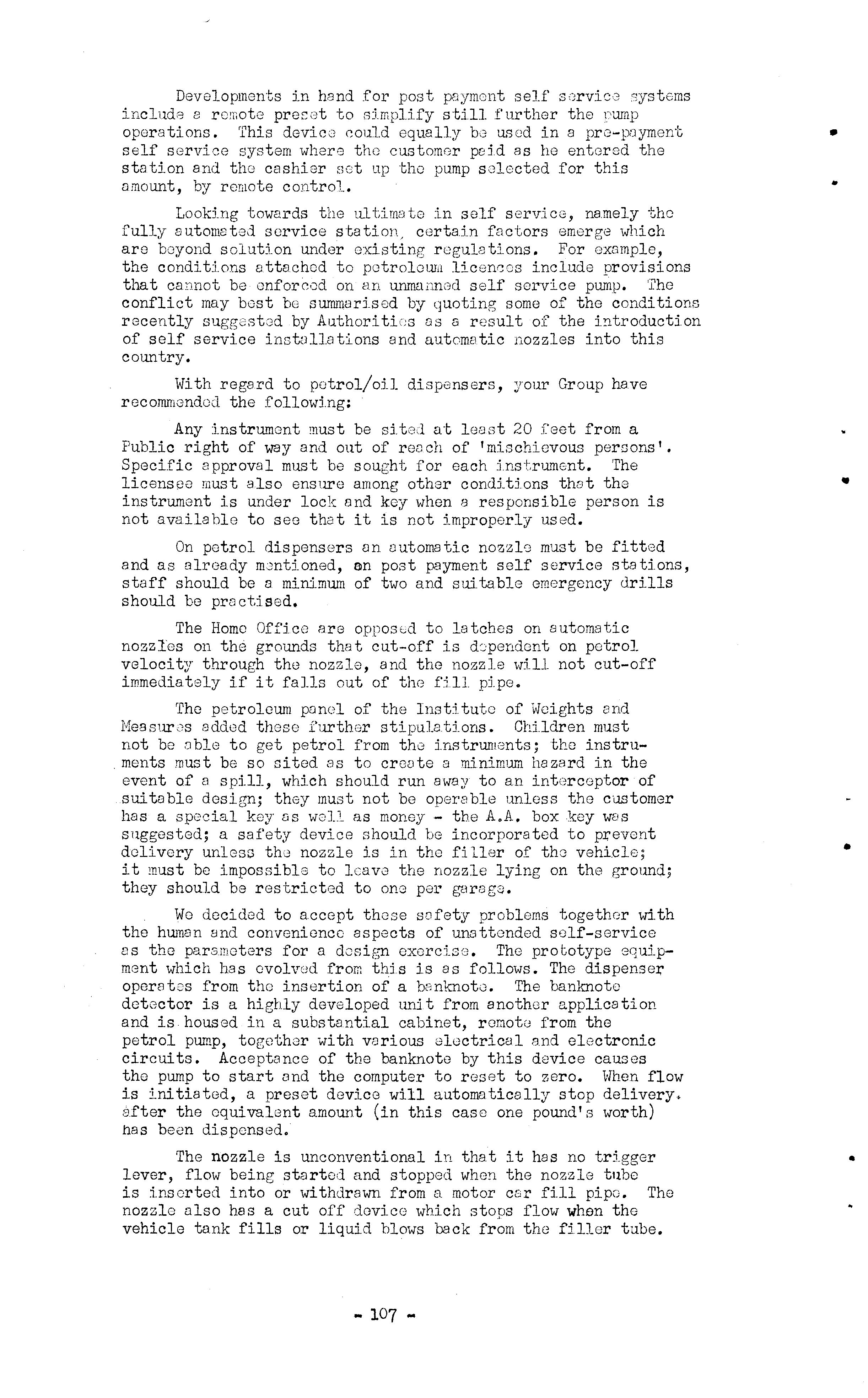
Wo decided to accept those sofety problems with the hwnan and cowrenience aspects of unattonded solf-service os the parameters for a design oxorcisu. Tho prototype 8quipffiGnt which has ovolvud from this is as follows. The dispenser operates from the insertion of a bcmknoto. The banknote dotoctor is a highly developed unit from another application and is housed in a substantial cabinet, remote from the petrol pump, together ·with various electrical and electronic circuits. Acceptance of the banknote by this device causes the pump to start and the computer to roset to zero. Hhen flow is initiated, a preset device will automatically stop delivery • .efter the oquivalent amount (in this case one pound's worth) has been dispensed.
The nozzle is unconventional in that it has no trigger lever, flow being started and stopped. whon the nozzl(, tllbe is inserted into or withdrawn from a motor csr fill pipu. The nozzle also has a cut off device which stops flovl when the vehicle tank fills or liquid blows back from the filler tube.
1 0 7 ... • • • •
This operation is
of flow rate. Vap01Jr is drawn away from the fill point through a socondary hose and vented to a safe location.
In conclusion, it might be said that progress is morked by our ability to moot, accept ond cope with ne\oJ events. It is felt that pationt argument, demonstration and co·-operation,:. between the interested parties will Gventually produce the correct solutions in connection with this subject of self service for petrol.

DISCUSSION
Mr. G. Dean (Solihull) said that the Group was not in favour of self service, but accepted that sooner or later it would have to come. Was any incentive being offered to people to serve themselves, similar to Continental practice where there \·18S A. reduction in the price of the product?
Mr. Spalding. If a motorist is running out of petrol, he will not mind serving himself. Therefore, on emergency self service no financial incentive should be necessary. It has been customary on post payment self service, which must compete with the conventional filling station, to reduce the price of the product as an incentive. It is thought however, that such incentives might be avoided if the equipment could be made easier and more attractive to operate. The customer might then be intrigued with the operation and take pride in being self-sufficient.
Mr. J. Beer (Worcester) asked if there was such a real demand for self service.
IvlI'. Spalding. There appeors to be a growing demand for various types of self service facility, not to supplant conventional service, but to be complementary to it. For example, shortcomings in after hours service and peak period service are the main problems for motorist and filling station operator. The Automobile Associations stated that the majority of their calls were from motorists who had run out of petrol. One major oil company in Germa.ny will be turning over one third of their outlets next year to coin operation. The manufacturer's job is not to create new trends of this nature but to anticipate what the needs of the trade would be in advance and be ready with the right equipment at the right time.
1'1r. W. Natthews (Derby) had misgivings where new equipment was to be install.ed on service stations, especially self service pumps, and he wished to know how best to advise his Local Authority regarding the licensing and control of self service pumps.
Spalding. As the. Group would appreciate, his company was a reputable manufactUrer who could not afford to act irresponsibly in the marketing of new equipment. They would always take all steps to ensure that equipment W'as safe and reliable and to this end it was essential to obtain the co-operation of Local Authorities in the development stages; the carrying out of controlled and informative experiments.
Hr. D. Hall' (Newcastle-under;..Lyne) said he understood from the paper that with the safety nozzle development, no delivery could be made unless a car was standing in front of the pump. How was this achieved?
.. • .. •
108
Mr. Spalding. The dovice incorporates Cl transducer Hhich senses the mass of the car Gtandjng in front of the pmnp. Unless a Igot signol "JaS received from the transducer, no delivery could be obtained. However, when carrying out Weights and Moasures t()sting, simple arrangements could be devised to onable delivery to be made into a IChekpumpt measure.
Mr. Bloor (Kiddcrrninster) askod if 'any of the pumps dGscribGd had boon and wero they economical to produce.
VlI'. Spalding. ltl8 have produced at least one model of each of the devices described. They have all worked successfully and some of them are undergoing field evaluation. Nevertheless, we are at an early stclge in the art and development work is continuing to improve performance and reduce cost. Indications Bre that all the devices can bo made oconomically providing the quantities required of each are reasonably large.
Mr. E. V. Beeby (Rugby) proposed the vote of thanks.
Dolo§;ntos then pnrtook of too unO. refreshmonts kindly providod by tho :,:o.yor, Councillor T.C. Bm1dlor, J.p. G.\[. De(m proposed the wo. rn, uno. sincere o.pprooio.tion of tho Group to tho I=nyor uni tho Shrewsbury Corporation for the woloono, fo.cilitios and hospitality oxtondod and also to Er. R.P. HOlclnrmy for nnkin0 tho nooessnry nrrnngenents. Councillor T.C. Bm'vcller suitably rosponclorl.
So onded the bost attonded Group licoting sinoo its inoeption in 1958.
IN PARLIAMENT.
Para.ffin Vending 1:nohin08.
T'Ir. R .1';. Soronscn CLeyton) flsko 3. the Hono SOO rotary' what lifll.oon existed botvroen his c.opnrtment and tho lIinist ry of Housing und Local Govor.rJ!ilont in respect of tho pmvor of Ivcnl authvrities to grunt or rofuse por.nission for tho provisi'on of po.ruf'fin vending nnohines.
The Pnrlinnentnry Undor-Socretory uf Stato, Homo Offioo, Er. Christopher Woodhous 0, roplied that tho Hinistry. had boen infornec. by the Hone Offico,that loonl nuthorities who had inquired hod boon told thnt the Hune Socrutury had no plans for stntutory control of tho snle of pnruf'fin from thesQ nochinos.
In 0. supplementary question,,' l'Ir, Woodhouse said that t ho Homo Sec retn ry wns U'Vvo.ro of no suffioient evidenoo to justify oontrol of suoh mo.chinos under safoty logislation. (21st. Novor.lbor). '
From Reports frOl:1 Pnrlinnont. "Loool Govornmont Chronicle", 1T ovonbor 30 th., 1963 •

109 • • • •
?RIERL2Y HILL AnD N.:IXTU:1EG .KEPT !-, LICENCE.
At Brierley Hill IVIagistrates Court on the November, 1963, 11.tex Products Ltd. of DUl1kirk Avenue, ¥lost BrOllt"lich plea(1ed guilty to keepin;; or petroleum spirit and petroleUl11 :mixtures ,-dthout a licence being in force, and. to keeping petroleum spirit and mixtures in vessels which were not labelled, contrary to the provisiol1Q of the Petrolelllll (Consolidution) Act, 1928, at pre:r.ises in Canal Street, Brierley Hill.
The Company was fined £10 in respect of the former conviction and in respect of the latter, and were ordereel to pay costs of £33.12.0., w'hich included the fees for testing and analysis of samples taken.
The proceedings 'llere brought by the Brierley Hill Urban District Council" and it was stated that S.V. Robinson, Deputy Chief Public Eealth Inspector and Inspactor visited the preruses £\nd saw qurmtities of petroleum spirit and petroleum mixtures being leept there in various containers" some being not marked and others being proprietory brands of cellulose, enamels etc., which vrere !narked in accordanoe "dth the Petroleum Aots.

A 1,500 gallon capacity storage iV'as also seen and understood to conh1in Toluol, but yeas not labelled with the words I:Petroleum Spirit Highly Inf'lamllmble li in accord_ance with Section 5 of the Aot •
In view of the fact that a Director of the Company stated that Toluol vIaS not, in his opinion, a petroleum sll...1YLples of this and various other 1'1_uterials stored V{ere taken and paid for in accordance vdth Section 17 of the Act, and were suhmitted to a Public Lnalyst and Consulting Chemist for testing and analys is •
The defendant Company ,yas given written notice of the time place for testing, but chose not to be represented. The testing ,"vas carried out in the presence of the Petroleum Inspootor on the prescribed flash point D.F:aratus, and the flash points of the materials sampled were found to be less than 730 Fahrenhe it •
A full nnalys is later proved that the nmter1als wore I in fact, petroleum spi ri ts or nurlures within the meaning of the Aot, and certif'ic£ltes were therefore issuec •
.. • • •
110
l"T. li..L. :3100r.
COIY'.menting on the fact that vrhilst no aooic_ants involving the storage or use of petroleunl sririt have been reponed in the aroa, :Ir. Bloor stntes that is has boen noticed that some users tend to display a degree of cO:::ltempt for its potentid dangers. 1,::r. 3100r conti:cues It might be opportune to quote from the last Annual Report of Her }:Iajesty's Chief Inspector of
"Information was received on 60 nccidents in which petroleum spirit or petroleum mixtures were involveo.• Thev caused the death of two persons unO. injuries to 43 These accidonts indicate that there continues to be insufficient appreciation of the hazards ass ooiated with the handling of highly inflanu-,lable liquids!1.

89 licences are in force at various industrial premises for the storage of 183,721 petroleurD- spirit and/or mixtures and 50 lb. of calcium. Licence fees amounted to Z79.
t;ari3.ges and gallons of carbide of
A t()tal of 298 inspections 1-vere made.
F.T. Earris on •
123 lioences authorising the keeping of 165,512 gallons of petroleum spirit and d.xtures, and 3 lie cnoes to keep 1 ton 6 (nvt. ,of carbide of calci1.1111 'were issued.
stores.
A total of 346 inspeotion.B '-fere made to licensed 3 disused tanks were made safe.
WAR-::'rICK RoD.C.
l\\:r. E.A. Lyne.
There are 70 premises where potroleurll spirit is kept. 68 visits of inspection 'were made. Lyne envisages that the demand for petrol filling stations iirill become greater in the b1llledinte futuro, with oonsequent pressure upon Planning Authorities to allow more sites.
I'lr. Lyne reflects that the march of progress in the retailinG side 02 the petroleur:1 spin t industry can be seen in the develo<lIllent of a self service I coin in the slotf operated pUIn!' for dispensing a petrol/Oil mixture. Attention is tlrawn to the recommendation of the Group that these units be used OlUY on attended sites.
NOTE.
ll.rry or L.ssociate <ember of the Grou) vrishing to tnl':e part in v. Cont ill ental Stu,ly Visit is advised to get in touch 'Id th the Group Liaison Offioer, who Trill then re the oouutries to "'€I visited, tho osth-luted oost ete. Arra:1go12onts are n01if going ahead for tho 1954 visits.
AliIEUi;L EEPOR'l'S (Continued) •
III • •
The courrcT\J o:'1osen for Continental Studies b 1963 ViTaS 1iVESTERH GERlfJIT, and yrith the able assistance of R. C. Dye, Publio Rclutions Offioer of the Eidb::}d Division of Sr.. ·ll-:=ex and B.P. Ltd. an introduction vms recdved to DETJTSCHE Si-IELL, an Associate Comp£'.ny of The Shell Potro13uH Co-J.lpcmy Lirlited. DE1JTSC}:::8 SHELL reCOl'Tlended HAc "'"URG as the most suitaOle venue for a visit, and wore duly 1,lo.de for 2. tDree. duy

Six Tr.e:;:bers of the Group took pe.rb in the visit: trm tro.velling by oar in advanc9 of the main p::<rty to the lcecess8ry contacts, o.nd the rer;lrdnder after crossing the Chan...'1el by various me8DS by train fro1:1 oche HooL of Hollo.nd. The [,dvQnc e party s ODlahOli-, riJ.G.:1aged to end up iD EAST BERLBT (Vb liThe T'[all" and Ei.STERN on tl1e vrny 'co Hl":J3URG, but nevertheless both mel:lbers were waiting for the 1218in '?i.wty at the Stution when the train arrived on Tuesday afternoon, the 24th. iNith typical German efficiency the train arrived punctud1y at 2.13 P .m. having left the of Holland at 7 a .P. - and aftJr carto.in confusion cO:l1cerning the o.l1eged loss of baggu.::;e had been clenred up, the p::,rty ..:.d-; ourned to the Hotel Base10r Hospiz for a leisurely and luxurious clean-up before meeting Dr .-Ipg. :=ax Haack and Eerr Karl lI'r. IConig-VDI at the hotel for 3 tour of IIJ,l·JURG.
has a population of 1.8 millions and is not the largost City in GEKIiJ:TY but d tbe sa:ne time a City Sh,te. The tour oT:lbraced all the main points of interest in the Oi ty and harbour area, althou3h it w<:\s unfortunnte th;,t part of the h.:·rbour "lives cordoned off by police bocL"\use unexplodecl British bonbs had been found L, tho hnrbour tnc,t afternoon. The tour ended with 0. visit to the Internotiom.:.l Hortic111tural Exhibition, which ,ro.s a most interesting display of typicsll of :nost countries of the world. Fir.ully the purty introduced to Nuremburg sausages and washed dov:Tn v:ith "schno."?ps" o.nd draught 00 er, in a dolil';:)tful rost::mroDt •
Later the s o.Lle nigrlt tI10 moro in.3;repid of the p,r'ey mac.e Cl pilgrimago to the faT:ous (or notorious depondjng Oj1 one I s l)Qint of view) IlReeporbahnli for n tour of this unicue ecmuS0l",lont centre. It certainly 1Yo.S Cl revelation.
Tho renl business of tno visit to Hiui.3URC cOlTlrr.Emcec1 D:C 9 n.:·,l. on :,VEDlJl.!;SDAY morning, 'when the party reported to 11 She 11 Enus" the Headquarters of DEUTS;HE StiELL for a discussion 011 the tochnical and snfety pro')lems involved in the constrnctio:Q and opordtion of Service StS.tiO:1S. Dr. H2.ack (md He'.'r Lonig wore by Herr Bind3r Ci.n en;in;;)or rGs}?onsible for Service Stcltions and De)ots and Herr Vonfred Linzbuch m,d the discus sion oj?onGd with I'm cxpla:c1?tion of t:;e Gc:r"; clas2ificutiol1. of spirits accorcting to Ilfl2.sh points". Tbis 17as as fol101Ts:
Class A.l up Jeo 21 Cc
I; A.2 tI li 55°C (131 0 F)
H A .3 55°C 1000C
li B Spirits J:11isciolewith water. Only Clussas 11..1, 11..2 and 13 are controll,,:d '0·' legislation.
Underground £'.nd their instn1lo.tion EOrl received attention, and it ,ms Stut0G oJ.1 vrore required to -. ·clded and to have a minimun lsgal of 5 r.uns .;' cltbough 6 Y'.ms. wns t\ more
\/ • • •
-112-
?raotio81 tl1ickness. The thiokness of :;, tank skin Tms giv:m by the formu_la: Diameter in :m::ns . -- . "3-3)- . .. -. ::
Before insto.llc.tion eac;l tank h£"d to be protected ,-iith u oontinuous coating of fi':JreiSlnss and bituTilen, and the oontinui ty WQS required to be proved at the factory by a high vol tc.ge licr2ckle l1 test. This vms an "auelil)le" test carriod out wit?-. hvo prods, one ,inside the tank [',nd the other on the ov.tside coZ'.ting. Tcmlcs usually had sept'rate dip pipes, t,luninium elil? stic1:::s sUPl'orted by oolbrs on the dip !,lipes :Tere the rule. Vent "Ji:?es h&d to oe of fI]?i')ropriate diflDeter, but there WtlS no ob:'ection to joint vent pipes for Cl ntl..."!1ber of tunks. Flame trnps Vf3re not v;:ere t!le pi,?6S v;erc ;;::!:; lenst 6 from' ferry point or oboye the eaves of buildi'1gs. Fhere vent pipes Fere low, "closed circuit" filling W'US adopted e:r:d G oOlmeotioYJ had to be made froTa the vent pipe to a speoial conneotion on the road t8.!lJcer. Thus, ,,\s Dotrol f1o\"ved into the uno ore;round so vapour WRS returEed to the ro£',d t::mkor.
. New tox.}:s '\iv-ore tested twice onoe b7 the mCl1uf8cturer vrith test et 2 ./sq .cr;1. (29.4 Ibs .fsq in.) and. onoe on the site with 1 (14.7 Ibs ./sc;..L:.). As ::\ m8tter of inter:Jst, hnd i),:cn tested f),t El -preSGure of 3 k::;./sq.Ol:1. (e.:pprox. 120 11:'8 ./SC:. .in.) and finothi ng h;ppen.:;d u •
The install.'tion of the -co:lks under norm81 soil conc1 tions
an 'was the sirlple O'.1e of excev8tion, fo11ol";eo. by of a bed of ['It least 20 oms. of Iisto;'1c-freeli or efcrth on which to rest the tU::0}:. The eX08.v.;t::.on 1'[8.S then "bz\Ck-fi1J.ed ll l'tith "stonefree li In ",r'Gas where soils 'were the -eles oould. require Cathoclio Protection, ant'I this W8S 00. either hy thG use of sucrificinl cnodes or by rectifiers.
Spoci0.l
vero cas;)s vrhore the " rOt:lld T[ater Wo.s These invo1vod the use 0:': H(l.ouble-sld:1!led" tanks the sectcrinf, of the t2;'lks G' ninst IJuoycncy the use of holdinG down let into concrote blocks.
"Douolo-skirmed l1 tnnks hc\d c,n out,)r sldn thic: noss of 3 rrn:'1S. in every case, ftnd inner trd_clr.J.1eSS of ei-[-hor 6 nuns. or accordi.ng to The '\iv-ere SG·('c;rc.tecl 'by u distance of 1 mm. Gnd. the OL1vity thus fOr'eed wes filled with cl control liquid which 11(:\d to be inc :o.pr.ble of freezing. A visusl oontrol tu;'e sbli1ar to [\ fi ll-pipe was G1s 0 arrnJ' with bell 8.nd. light vmrning to indieCcte any change of 10re1 in the oontrol liquid. In some oc:ses Cut:; odie Proteotion wos also required.
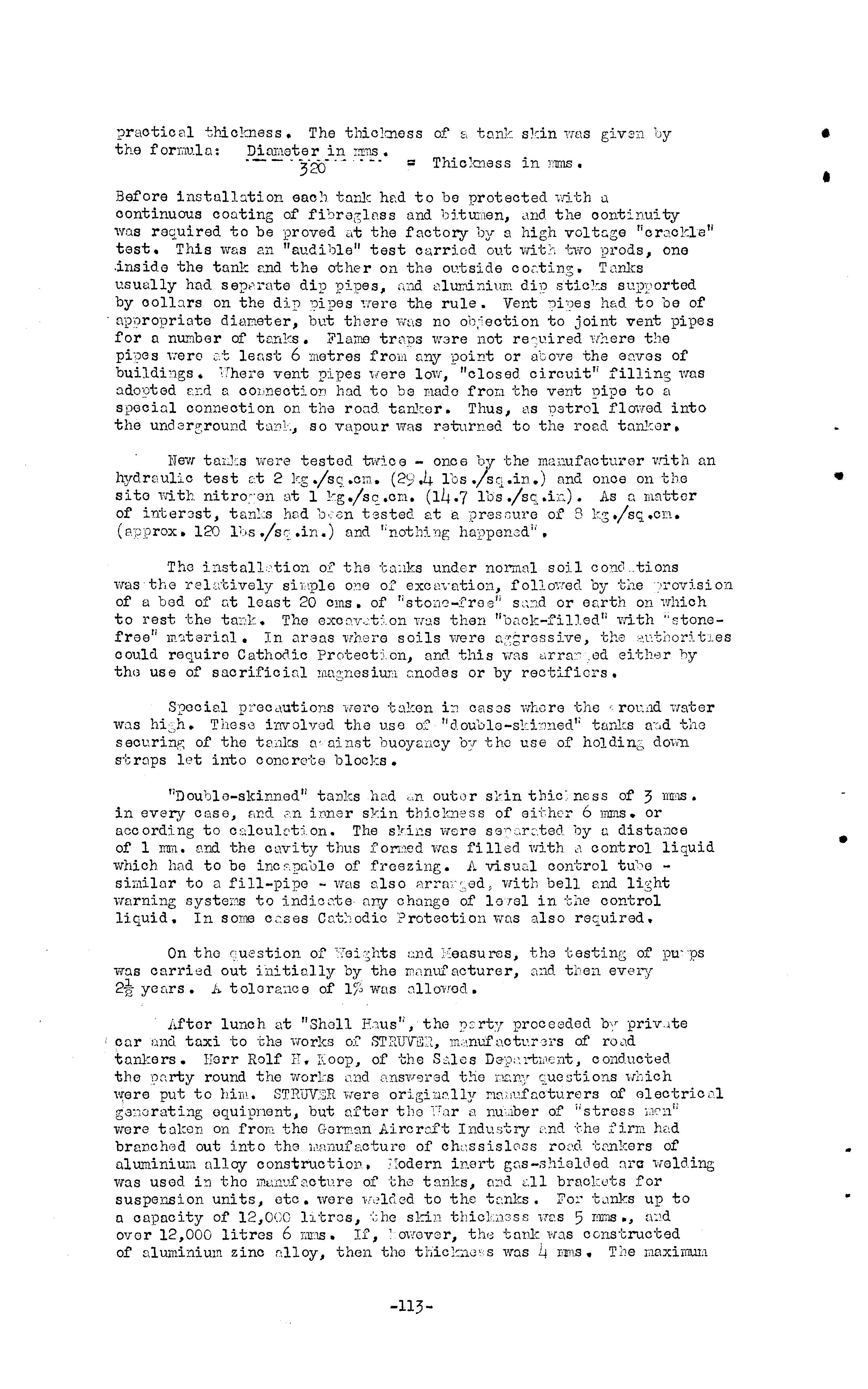
On the c:uestion of '-rei;;;hts t:nd }'=eusures, th3 testing of pu"ps was oarried out ini tinll;'!T by the m,-muf acturer, :,md tllel1. every 213 yenrs. };. of 1jS was ollovToc1.
Aftar lunch at "Sho11 E:ms", the ;:>:::rty proco8ded b: r priv."te car r:md taxi to the vrorks of m';'.nt1i' of ro ,l.d tonkers. Horr Ro1f H. Koop, of t:he DG·P:'l't,"lcnt. conducted. tho :l?c;rty round the worl;s o.l1sy.r'Jr8d t!1e r.12,ny H'ljich w:ere put to him. STRuv.;:.;R were origLlc.1ly !'l[);it,fncturers of G1eotrici'.1 g0:10rating oquipnent, but ofter tho Fnr <1 nU'"lber of "stress i:1('l1. i ' were taken on from the Gom_3n Aircrc.ft Industry f:nd 'che firm h;e:,d branohGd out into thG wmufc-..cture of ch:;ssis1oGS 'cL'\Ilkers of uluminiUlil nlloy construotion, in.ert gf,s-shie10 ed C\l'tI i;felding was used in tho mml'.)i'ncture of the tanks, a:ld <:.11 bracl:uts for suspension units, etc. were to the tc,nks. Fo:' 'bnks up to a cnpncity of 12 , OCO htros.1 -:;ho sl:in thicL.13ss ,nes :5 rDrnS., a:}d ovar 12,000 litres 6 Tans. If 1 0'\'!Gv8r, th(3 tank ,\'fo.S ccns-cruc'ced of nluminiUln zinc n1loy, then the "TO.S Lt :mtn.s. Tile r118XimuI:1
-113• • • • •
gross weight of a tonkcl" was 32 tons" nnd the naxiiilU!ii carryi'lg cl'ro.)ci'ey 30,OOC litres. 3:]ch C0Tl11Jal'tT18r.i.t wns of 6.2 cub. HO'GraS und the tankt3r could hav8 10 com;?nrtmer.lGs. r;lD.Xim:um rate of deliv;lry froiil a tnnl::ur was 10 metres }Jer secoiJd. The wiring systerl of all tankers was single before 'che fire shield KOcl double ['.ft6r the shield. 1.11 tad:ers must earth3d before c1isclwr r ,'e or filling, anI suitable s,-",rthil1g points vere provirled. The .icunl:s thornsebros were £,i tted l'[i th e.u'coDDtic v£\bres in the event of 'che tanl:er overturning.
The ?rincipnl advnnta 2:ecluimed for tho chassisloss liGht metal tonJi:cr "v'ns that of apnrticulurly high pnyloc,d by reoson of low weight Othor odvnntu'es 'were the low centre of due 'bo the tank being of' oblong or elli·)tic,l.1 cross-section thus giving excellent sto,-,ring propertiGs and the fact th3t fe1irer rO")Girs wore n·'edod due to the fibs onco of' 'braces holding-do m b8"ds. Light 11£3tal Jross membars took the pllocG of h3avy ch;o,ss is frames c\TId ensurod 8 satisfactory distribution of axle loads O'Tor the tunk shell. In one design the woiT,ht reduet:ion was so substantial tbc.t the actuctl payload capacity was boosted to pra.cticnlly two-thirds of the total ?:ross 1'oight of the vehicle. The unit had one axle 10ss than c: true];: fmd som.i.-trailer unit of s Dnil<:.r cc?ooity, and ttod for +,1112' first tLna ::'I payloH<'t of nearly 4,4:Jc g!O,l1o:11s.

All t::mk truc>.s for the trQns1)ortntion of miu8rGl oil :flroducts were fitted with essential ec!uipr'lGut S1.wh as pumJ?s, filters, ':1Bter dials, air hose re3ls, etc.
It was interest:'.ng to 188rn before wory: was cOLmenced rond te.w8rs, cClrri-:,d out by i;YdOnS of 8. This vms "CEF.Ji.BOIit !;, Bnd vvo.s iilDnuf,:;eturod by IL':l.G, of DUSP3;JDC':i.F.
Ferl d::-y, the 25th., tr.o purty set out at 8.30 8.',1. to visit 8 Depot at HJl:TITO"lr,;:m, trans::;ol't being by n "ini "bus". Some of the party had yory:rave doubts as to vr:lothor evon tho outsJdrts of HJ,J.ti'BURG would be reached without disas'cor, but all '(Gnt 'h'oll on tho 100 miles or so journey E.long the autobahn. J,. stop 17{E',S Ii11.1de on the way to. e:x:ard.ne an Autobahn Filling St::tion, cnd it vvas explained that the design :md lcyout of all Filling St2tions on f',utobc:nen had to conforn 'wi th tha rootlireT,:ents of the Autobahn Aut;JOri'by.
The to be both a rail head and El rOCld tanker Distribution Dopa'c, a::1d there was much of interest t6 be scon. In p8.rticulC\r th8 oP?ortunity W8,S taken to climb to the top of a 2,250 tons capacity stora;£,e tant. wlrich li!8S UDder constructj_on, but this was another haz:::Irdous bGcause of the 170athcr wet mn windy. At the time of tho ius?ection 211 the welds were being tested by nn liX_ray" Il1Bchino.
Lunch was taken at a spleno_id rest[n),runt attnc;"cd to a brElVvery, :un aftenV"2,rOs a detailed examination was lTIc.de of another Filling stntj on. This was Compnny-avVlled site, and ,rere many novel features, ono of v{hich vms tlle carrying up of the vent pipGS through one column ut the front of the i'oroeol'rt. Tho top of the oolmm was then used as t't flcgstnff for the Company "house tl f18g •. It was understood that this was quite coym:.:on practice. Circui t-breo.kGrs t'loemed to be the rule for the ,?roJecctiol1 of eloctricul oquipmmlt. Lightweight autowntio noc'::o:los were also in CQT,llilOD use •
Thor.. fOlloliied the return jourl'ley to IIK'fBURG in '(;1,0 lildnibus f1 but it was interesting to Dote tbat oi ther the now h2.d cOnIplate oonfidOJ.1ce in the I1Fangio-stylGt1 drivor or th,]t the exortions of the dny hr.d blJen too much, all except those hl the front socts proJ1.ptly fell nsloep. It could clso havo been dU8 to the anaesth3tio affects of lUllCh.
• • • • ..
-114-
On FRIDi>.Y, the final day, e rEeoting hetd been arranc;ed with IIp.T.A .'1 _ the Petroleum Trac1e k;sociation, w:"ich wns rcs:;)oDsiblo :(,or £\11 technical ;-'lc.-L-ters. This .vas held et the m:'fic0S in lI.iU'ISURG and Was presided over by Horl' "J:i.:'::UQ'.fl'", Dipl. Ing., the Technic a1 Officor, Herr Johannos-l"Inrtin Chicf J!:nginoer of BP BEi,::,II1 U)\lT) P£JROLBm:, HlllmURG, and our Horr rblLG vlere also prescnt.
The in appcared to ba thc R3guLttions wero only 8 frarnor:ork, and nU tochnicel ,:,s'lects '.'ere "onlt vd th by the PctroleurD Trade Associ:.tiol'l in conjunction Trith the autlioritios. All inspeotions, trl:llc tosts, etc., wore carriocl out by the PS.A. e.nd if irregulgritics were fou:od one cO::?y of the report vms sont to the Head Office of the Coqv,n;r concerned and ono to the in:i.stry.

Inspections took plsce every two yecrs, and tm1J:s 'were routine tosted every ten ye1rs "vith n5.trogon at a prossure of 29.4 lbs /sq.in.
On the quostion of the LlstalLxcion of undcr'·:round t::rn}(s, the point was ITl£\dc thC'.t d 1 'ring the po riod of 1940 to 7,OGO tanks were romoved frOLl 'chu 2;round r'.Irl only 0.7<f; shovmd any evidence of corrosion. : :uny were inst2.11od before 1936, and 811 had the standard protection of either u of jute and bitumen or fibreg)ass "nO. bi d spending u.pon the <'tute of instnJ_lntiol1. 0.18/; .fere "written off li , the others rcpdred E1'd used ::'.';nin.
Plastic tanks Tlora no'c ?avoured in GER iJ.TY 0i'clll3r for unc1.erz,round tanks or road tankors, princip8.l1y bec:;x!se they could :'-lOt be flonrthed".
Tho st:mdard for firo extinguishers was 1 for up to 2 punps ond 2 for mol'€) 2 pumps., The could either be Foam or Dry Povrcor.
It Was ststcd thnt Protection Tle.s nOGdod for one third of all tanks. If the resistance were 10,000 ohms/cm. or more, cathodic protection v:as not requtrod, but if less then th'\t figure then it was essontial. The opinion ..vas expressed, howGVElr, that 10,000 Om'ls/cm.1i'8.S too high. cathodic protection was provided on insulated flanr;o was insorted t the pump to bronk the electrostatic cOl"lLection.
The party then adjourned for lunch to a restaurant at the Hautbahnhof as the guests of IIP.T.A .11 o.no returned. to "Sho11 Ecusl! f or the £i1181 session. Hare the was takon to proposo a vote of thanks to Dr. Haack and his s'ca:(':I:' at DITUTSCHE Si-IELL for the VG'rI/ excellent arrangements which h::-,d been Hl8de the visit. HA BURG 1inl.l long be rCr.1Cl'1bered ns c mngnificient City, nIlli for their helpfuhiess Ont'! hospitaUty. }Ierr Konig, in particu1;;,r, will be ror"c1ihor'Jd "i'lith c;rntitude not only did l1e r,ct 8S n full-time r;uioG ami cou:Dsellor, but he nlso l}rov8d to be a very competent Without himthine;s oould have b(H3l1 a little difficult Z\t times.
After s;)ying f,"'rewel1s the p2.rty then sot ouJe f Jr 'C:'6 'ong trek horno. ThrcE' of the. more nfflu(:ll1t ,;leJ"crs r:::turDOo. by ·:;1'.'\in and pl::E10, whilflt c :1r trio mo·GoreC!. 2.1most cO\l.thmously thrOl1(;h Gl3rr,n:i.1.Y, Holland [lnd Bol:;i t'B to e. This j our7lllY wns l:1Gset by luok of funds, d8rlmcss .electricdl stor-11lS, but neverthel,')ss the oxperie,.oe was thoroughly Clyed. The' -id 1 a r:,(I S W:;lS rN\ch,'d about nidnight on Saturdpy, l'then. tiree' but triumphrlnt travellers r'<:tired to bed to remdn thore for rlbot of tho noxt day. So enc cd [\ J'lemoro.ble visit.
-115• • • •
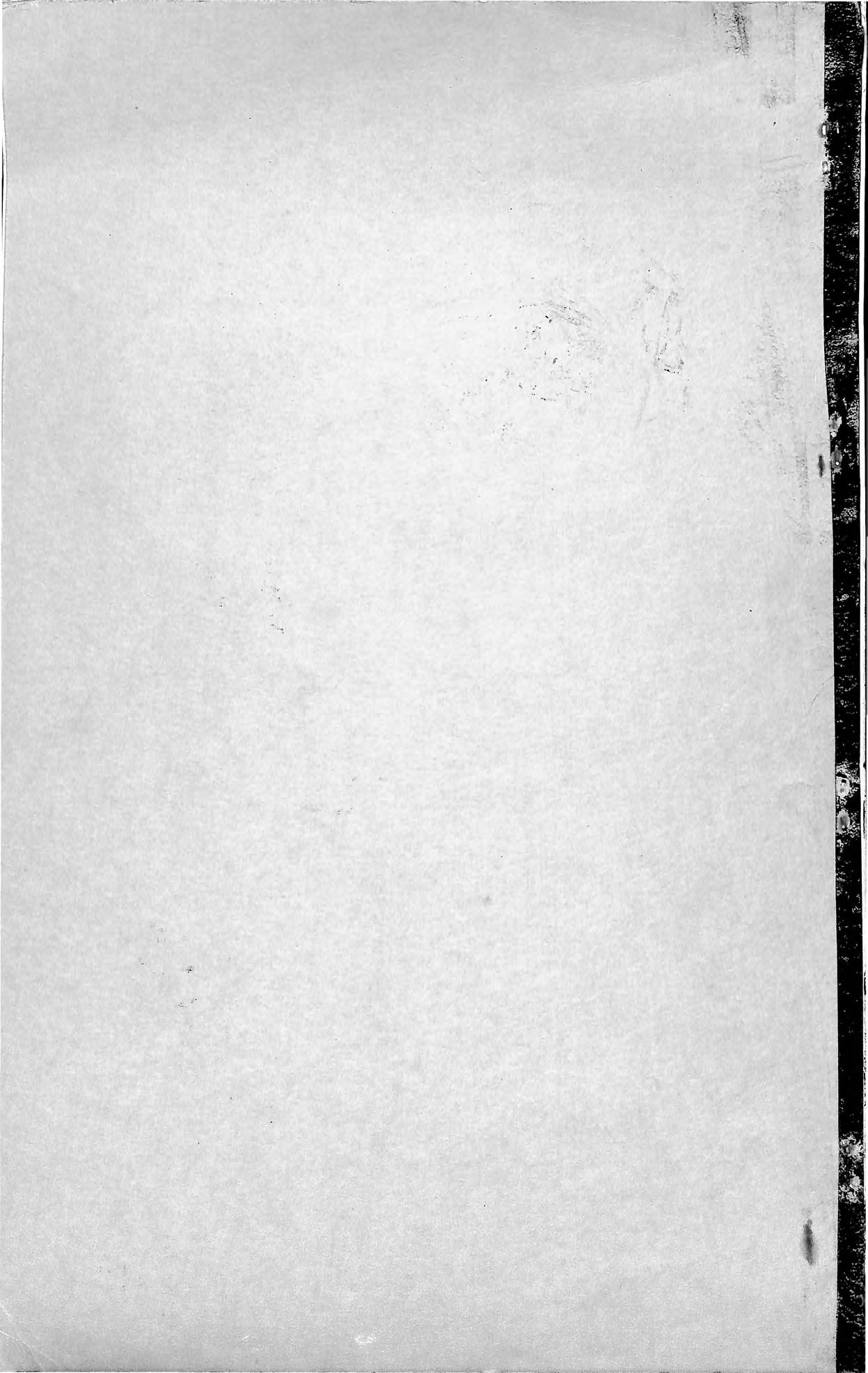
... f · ,

